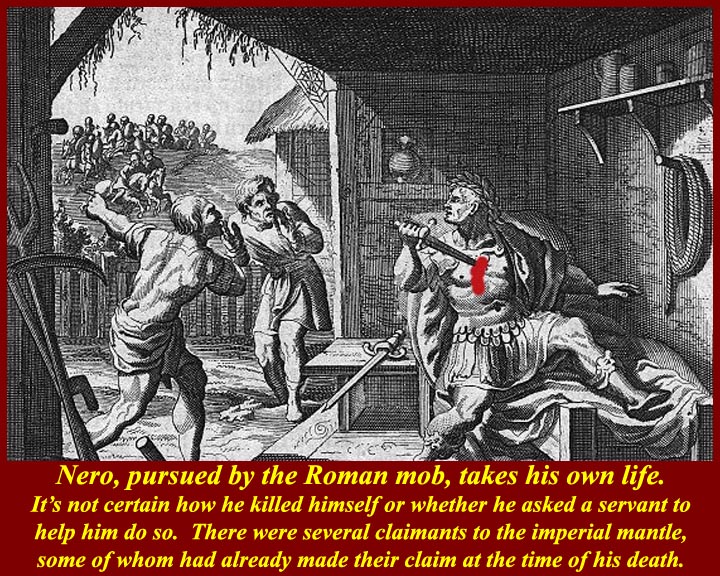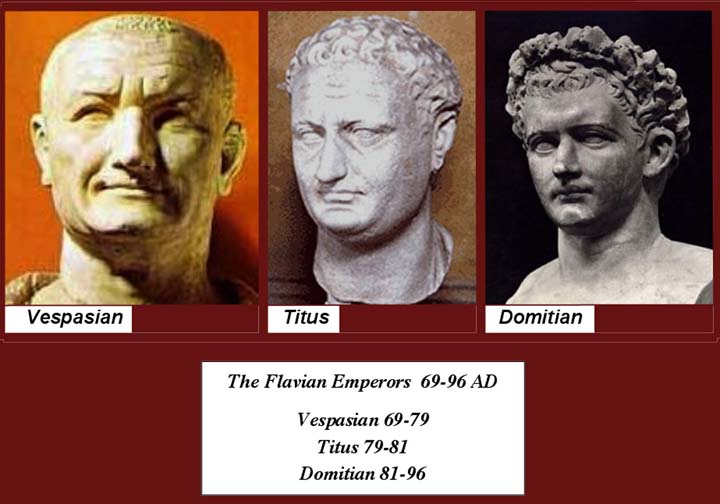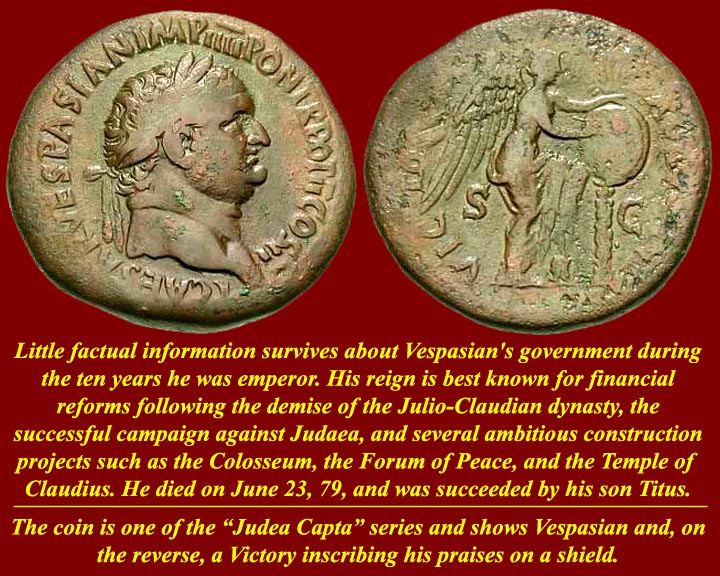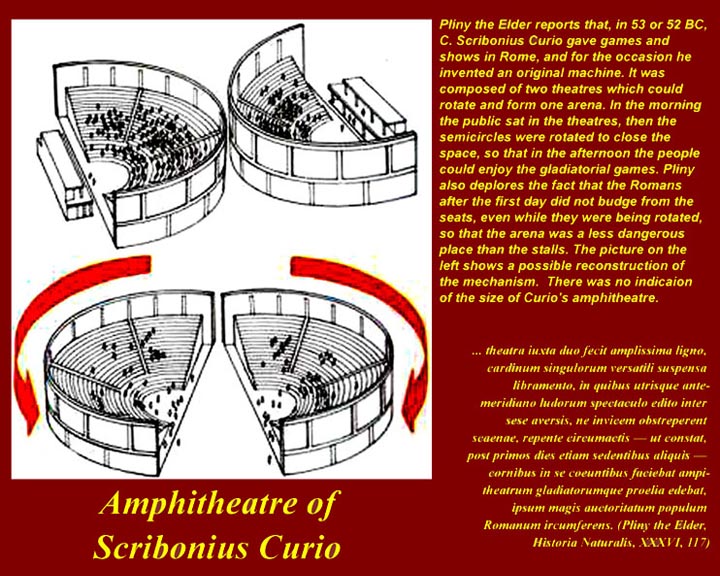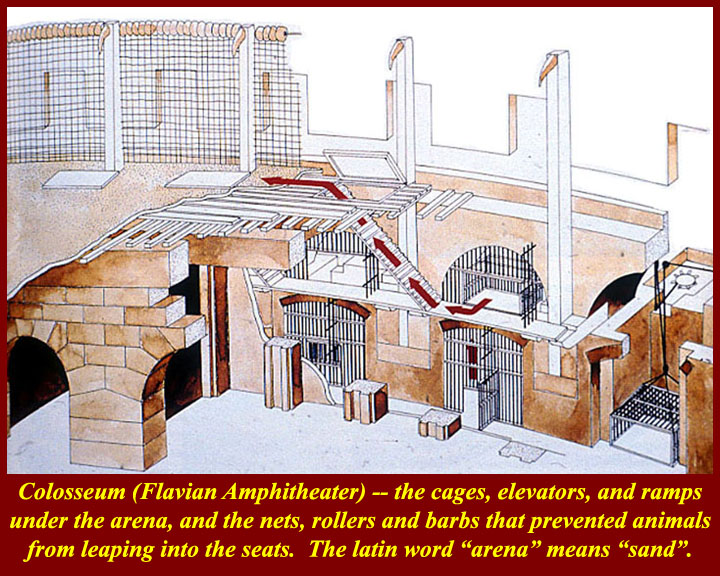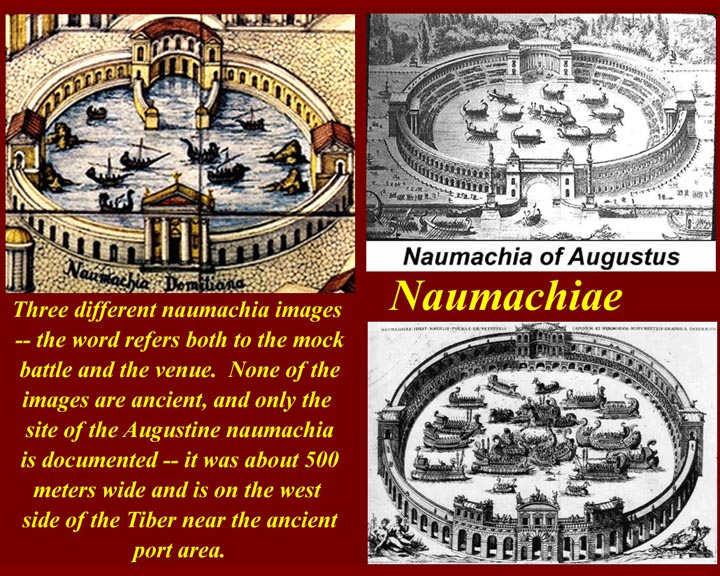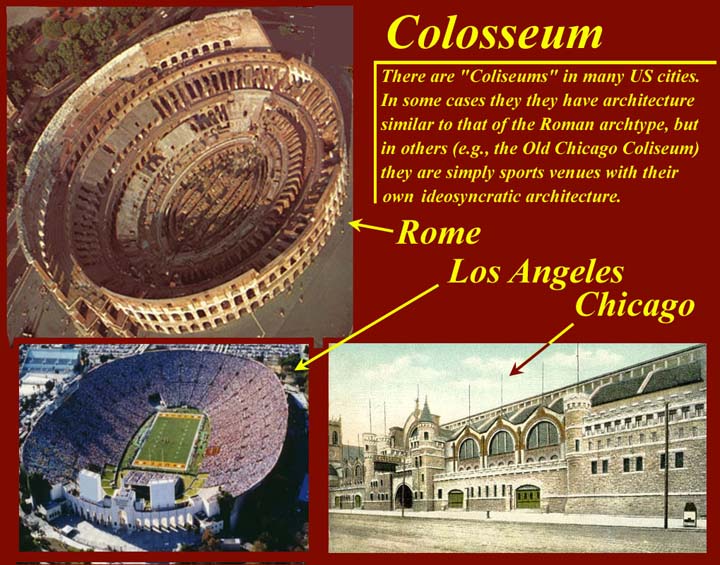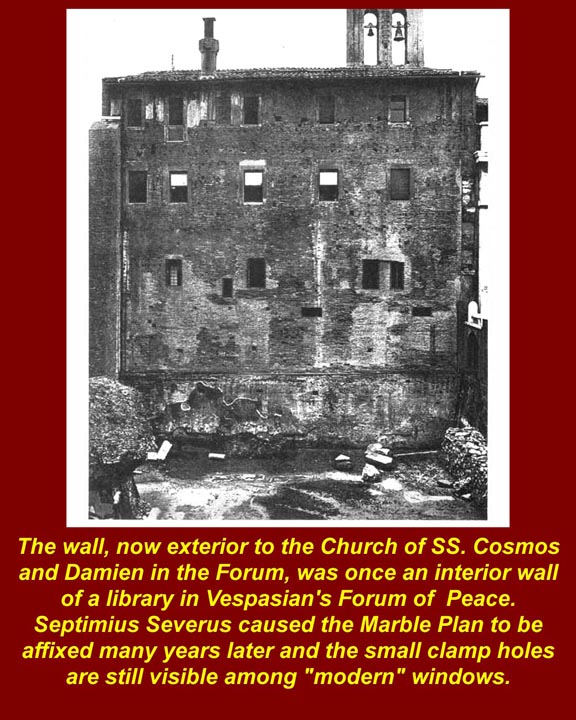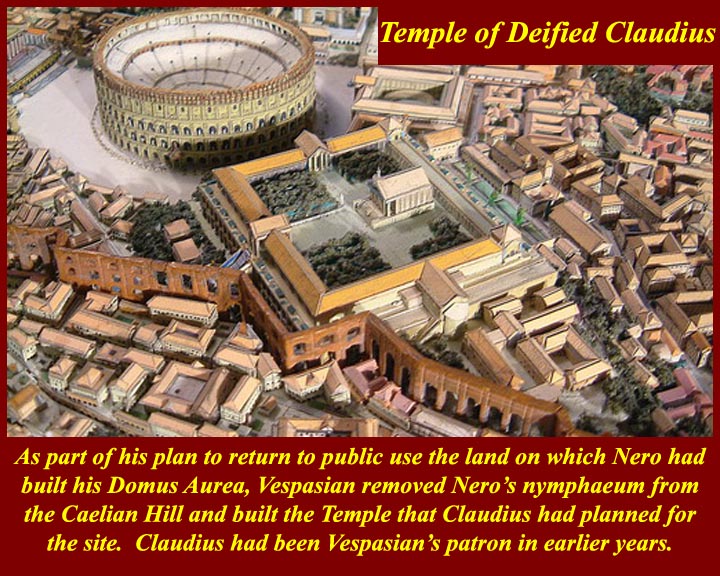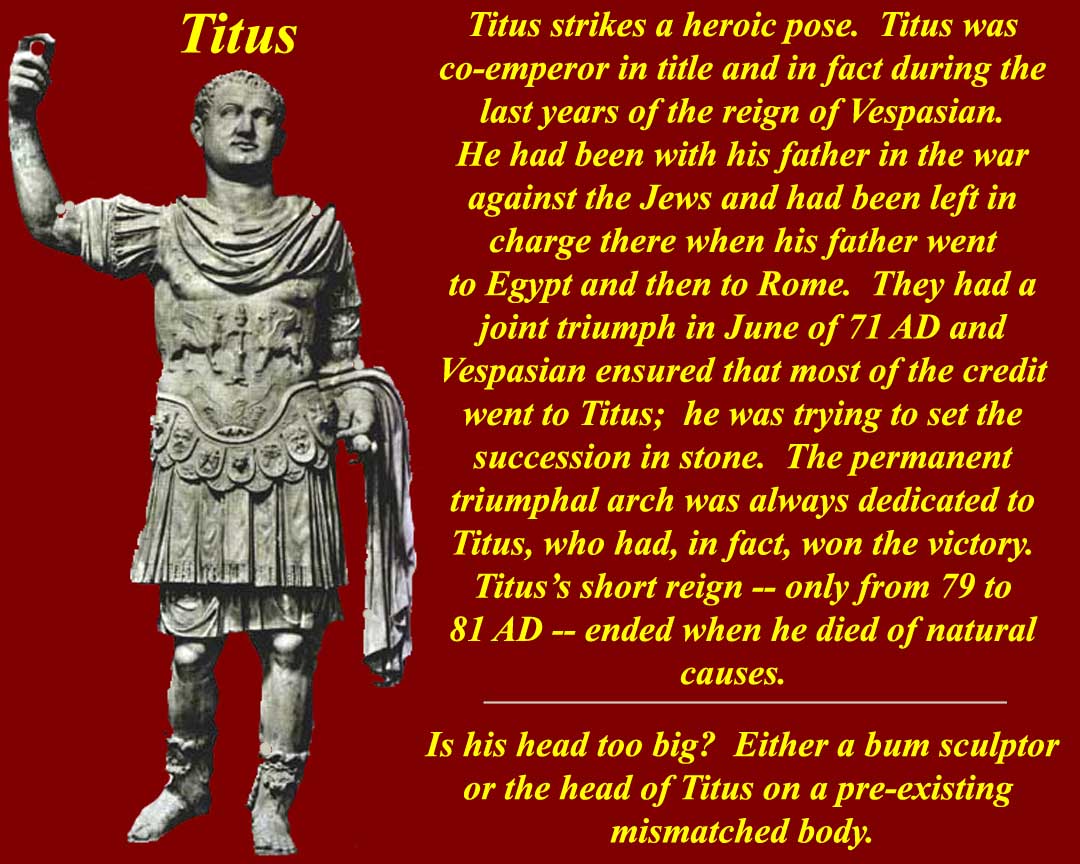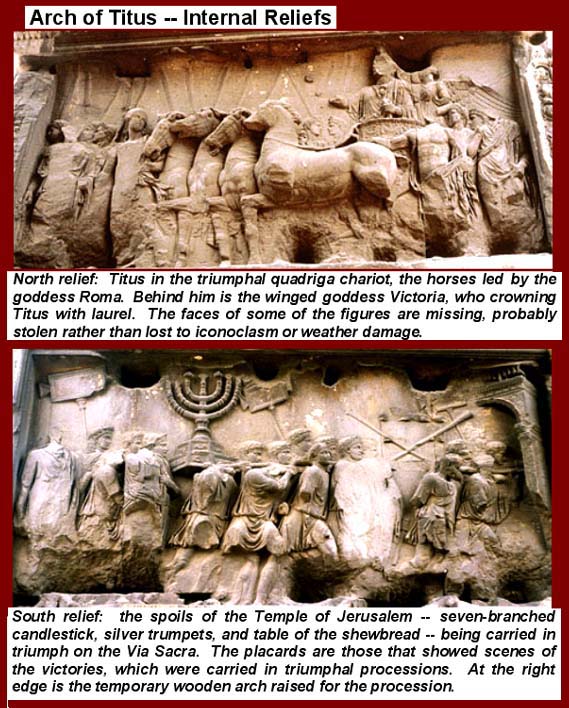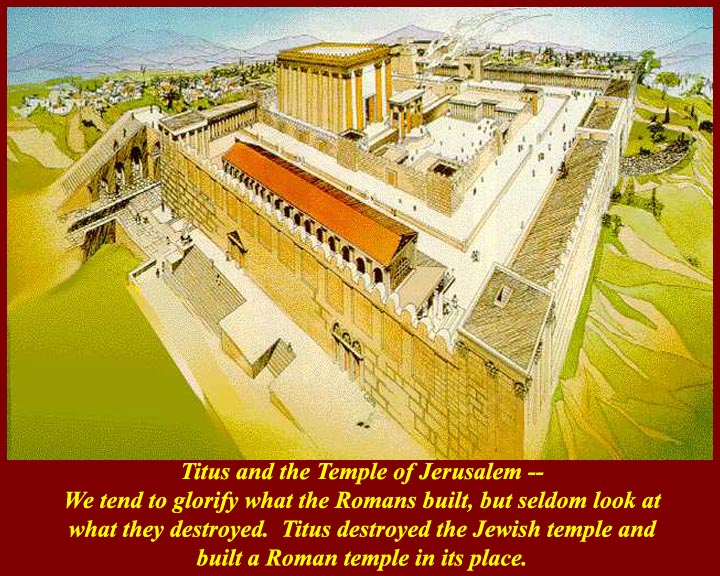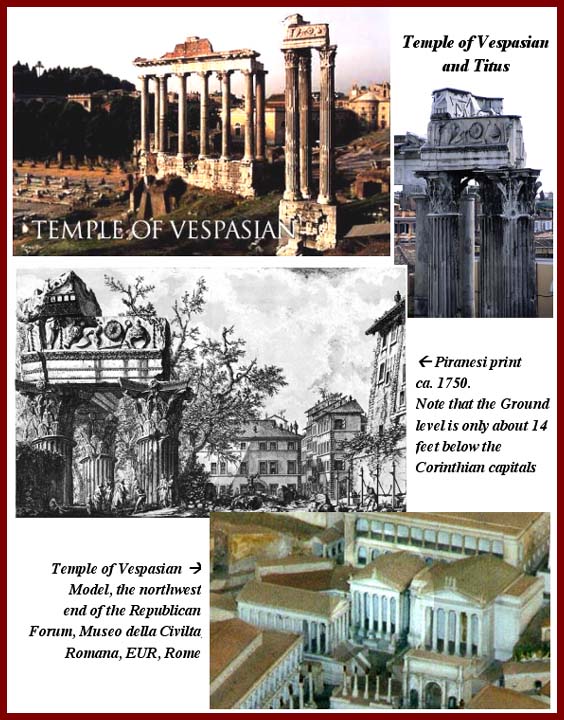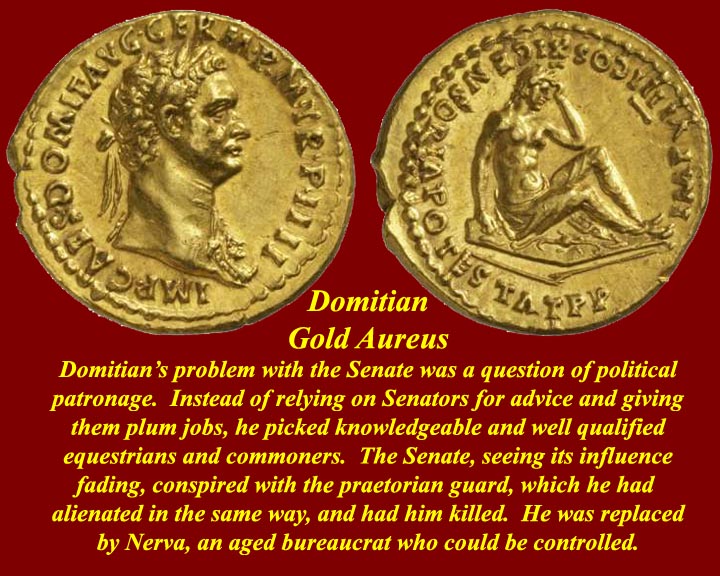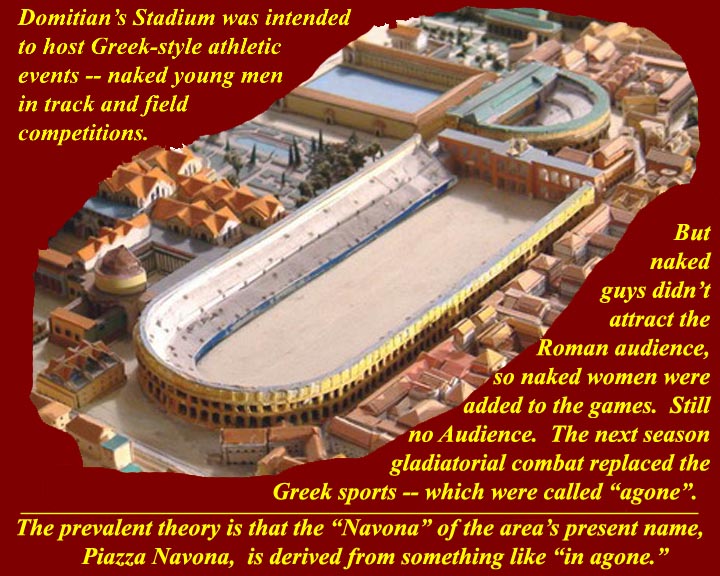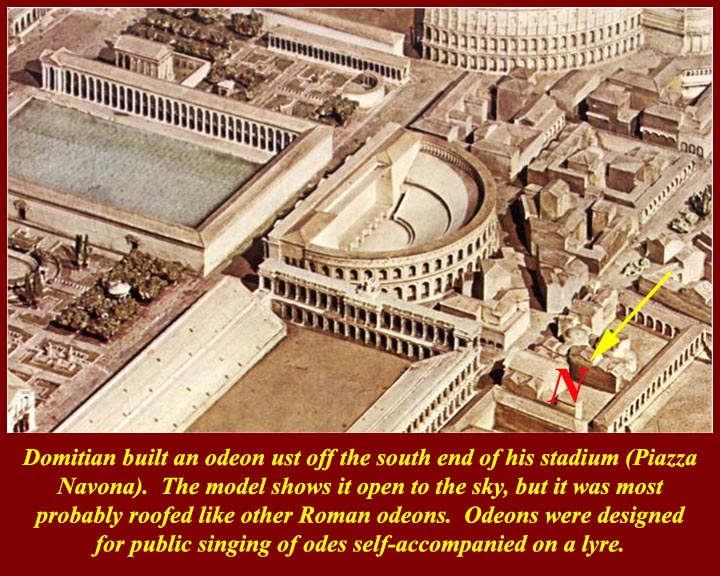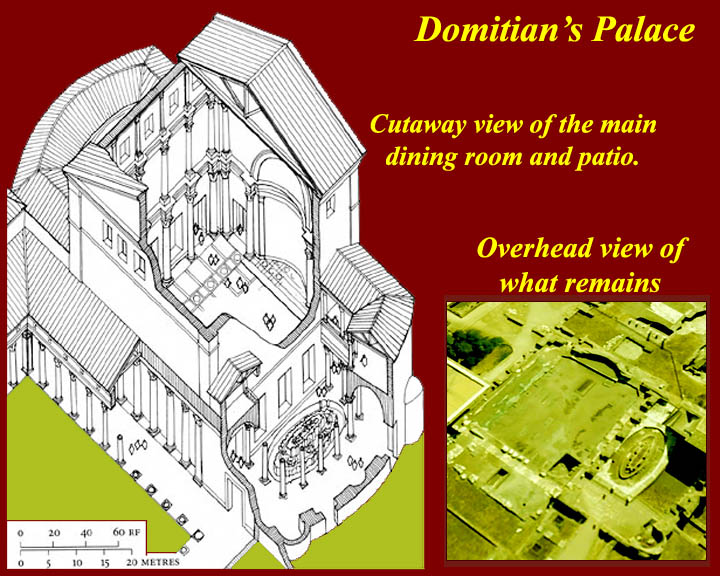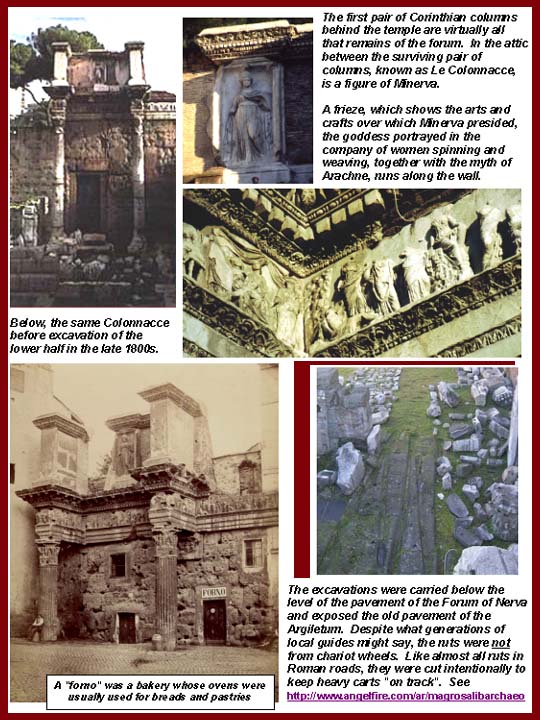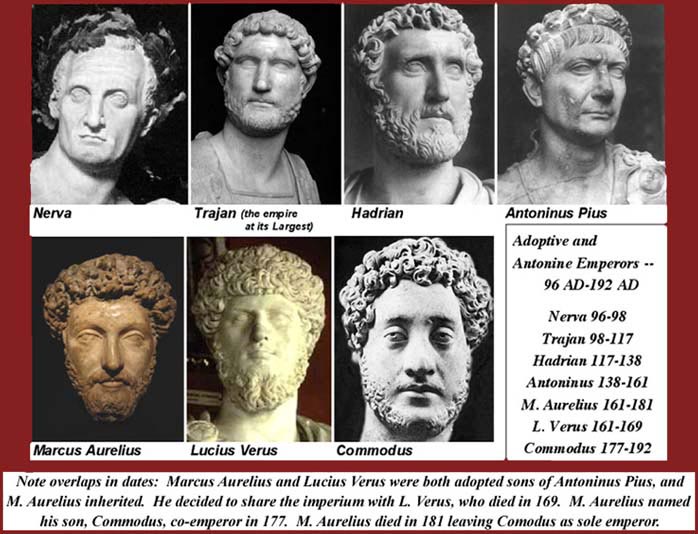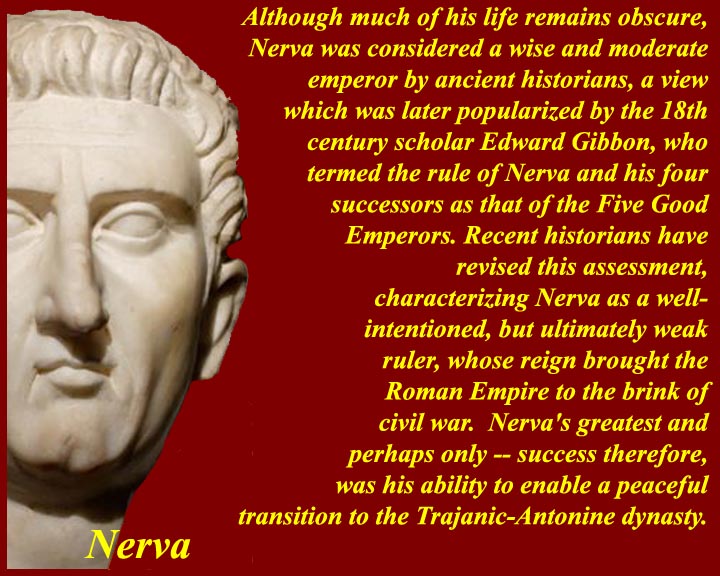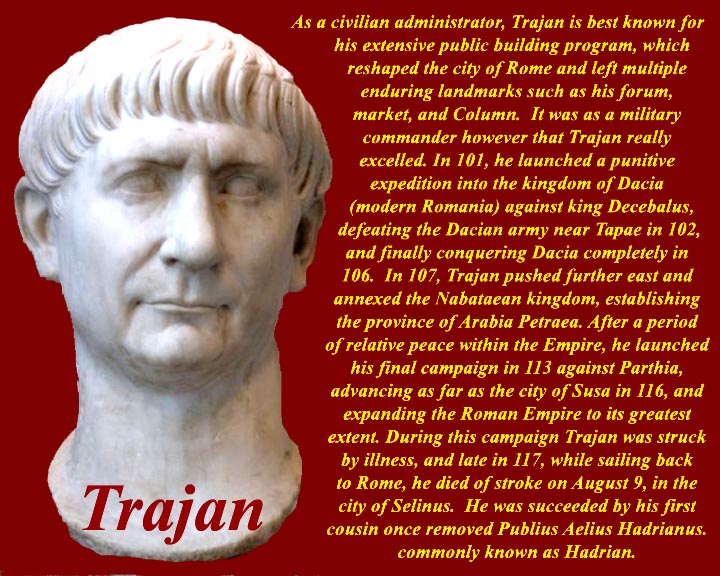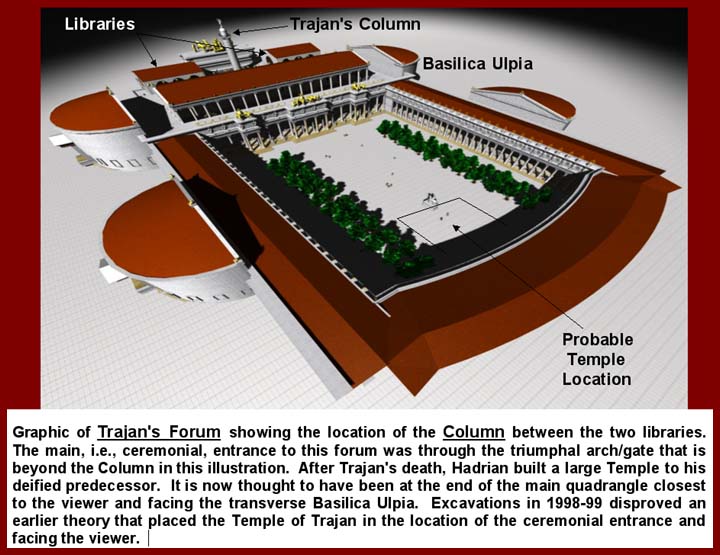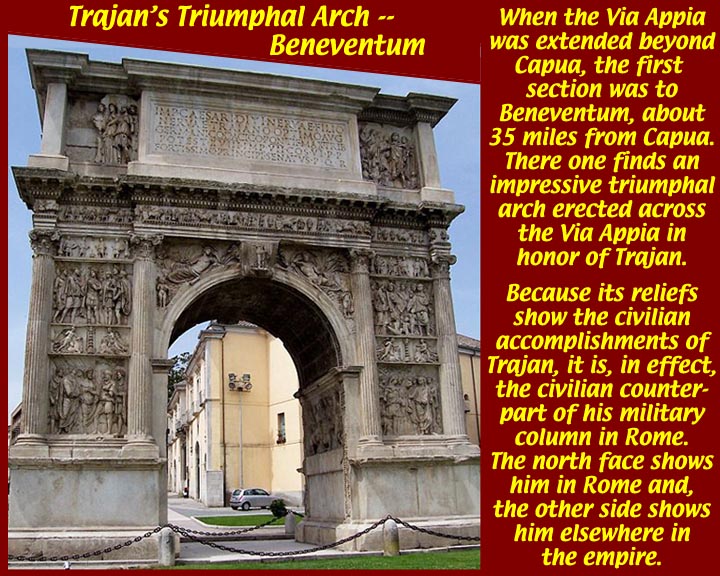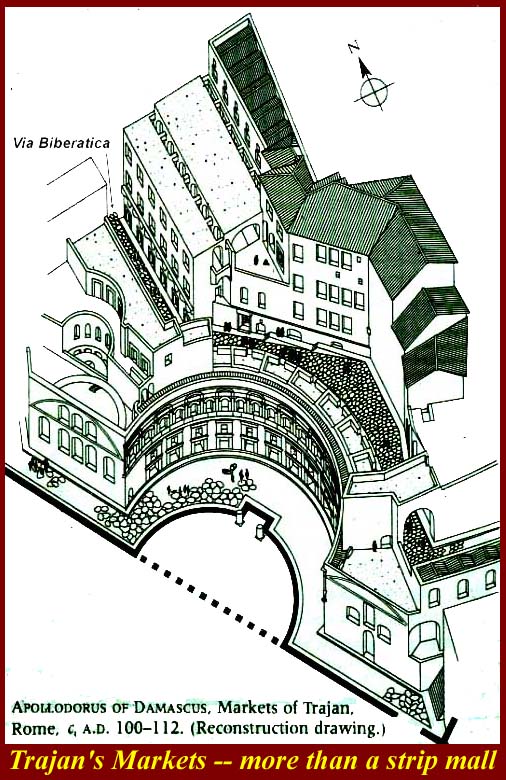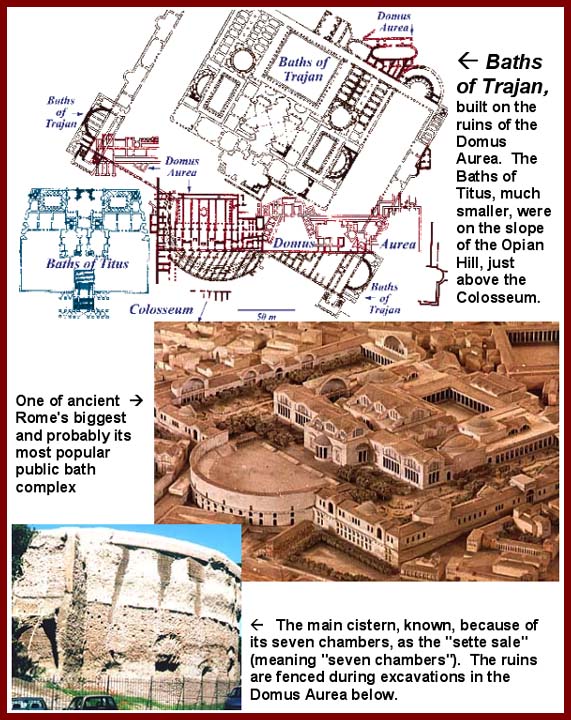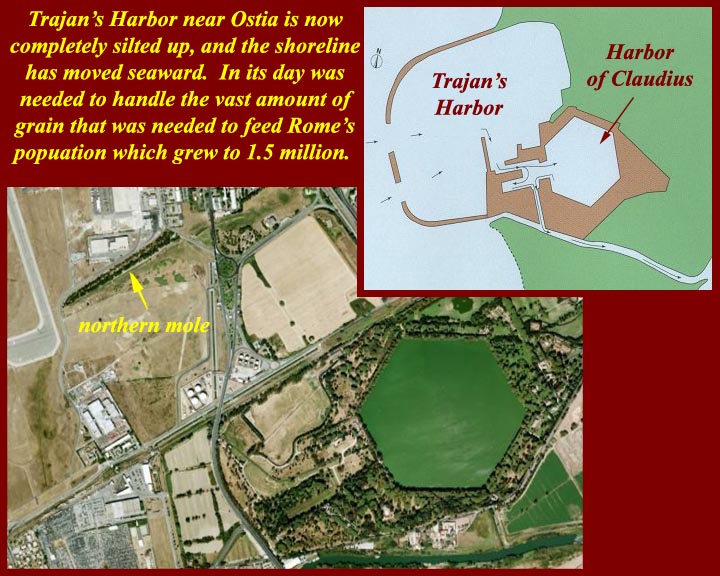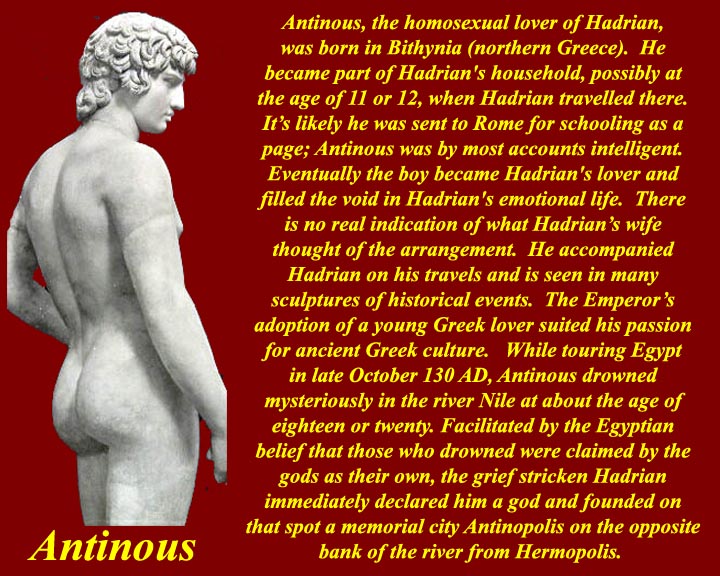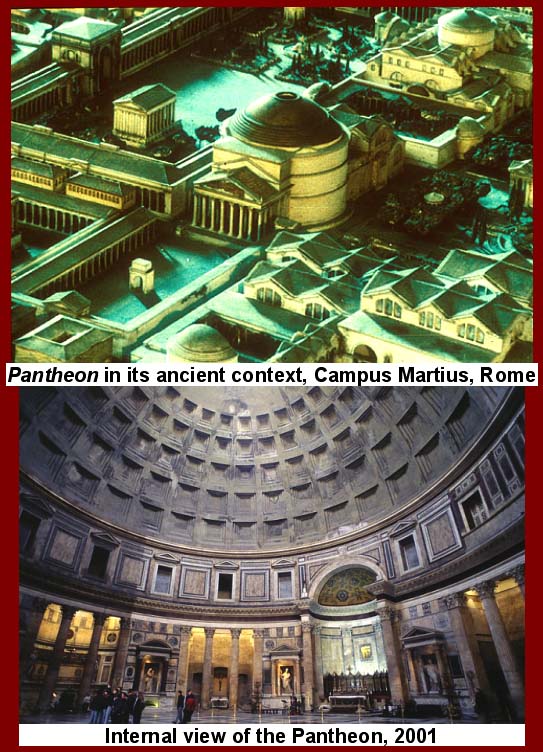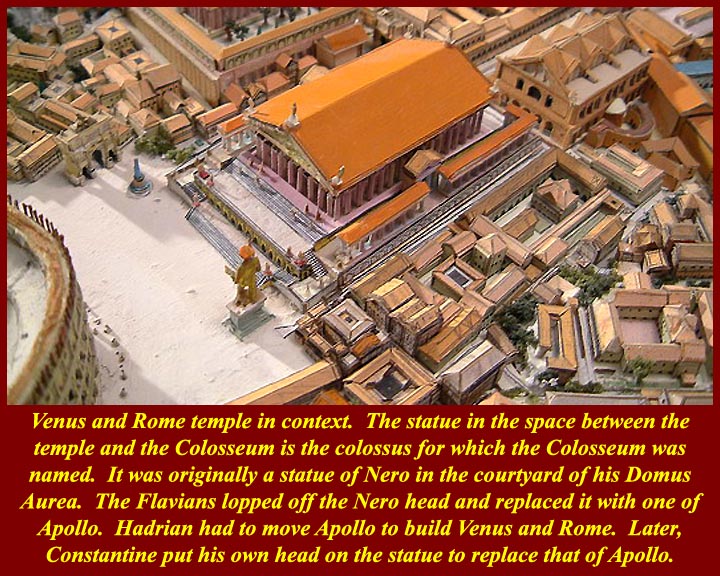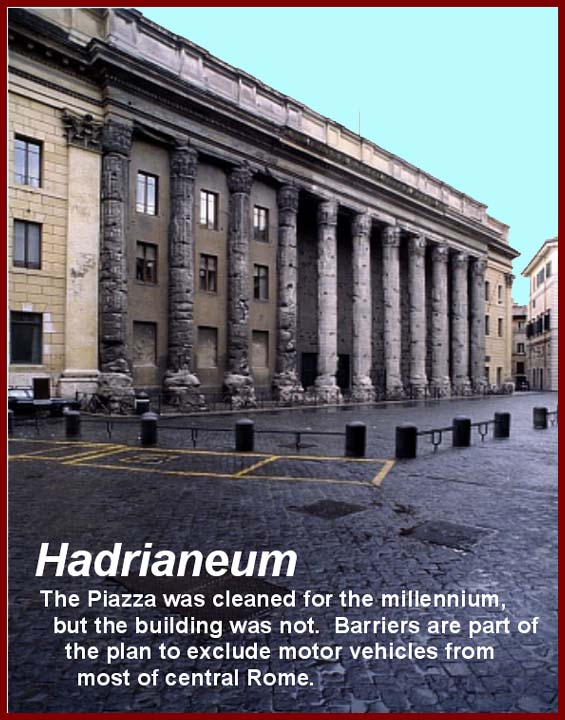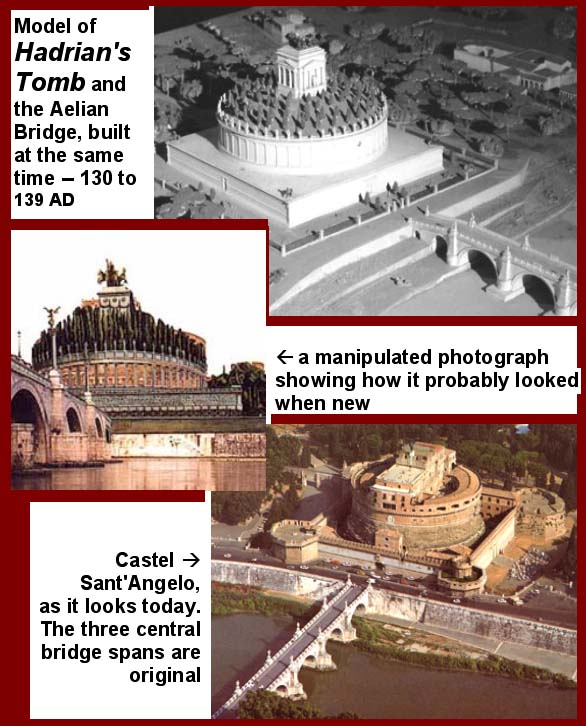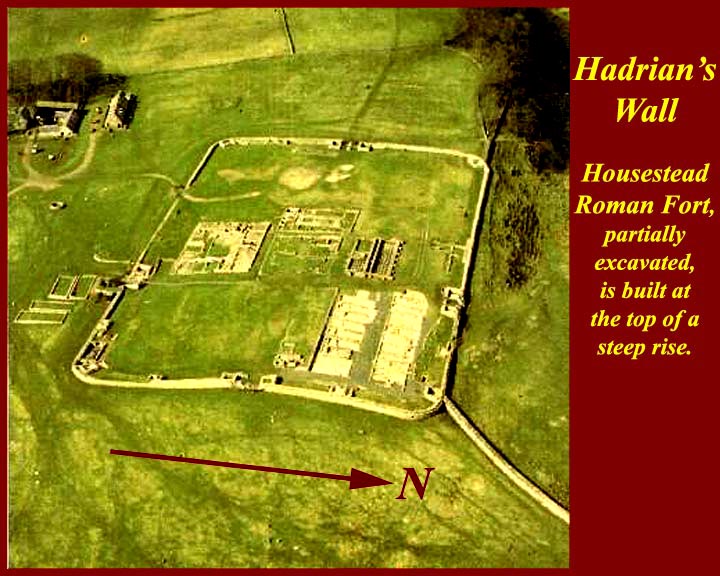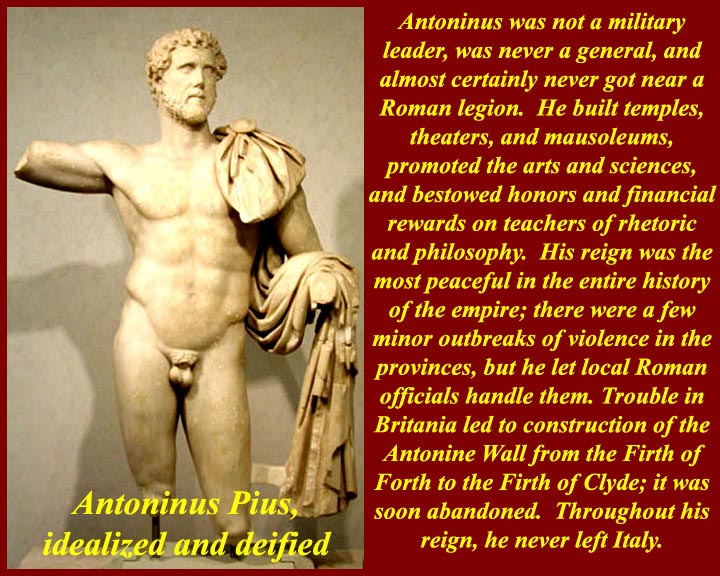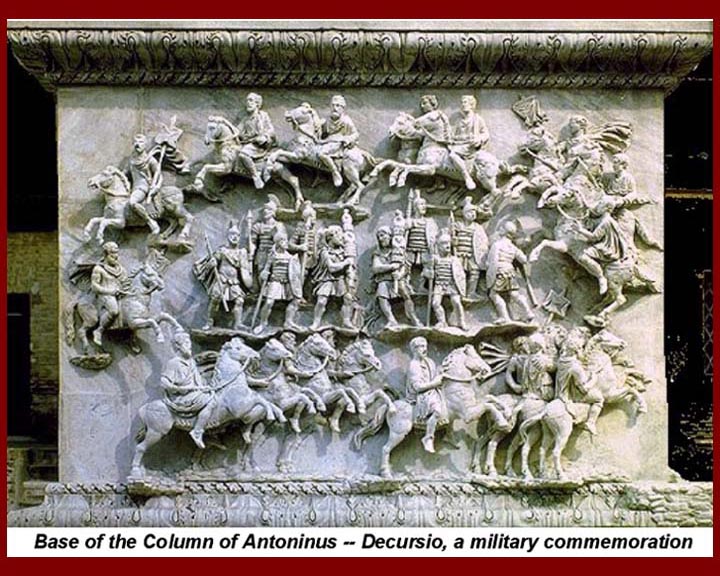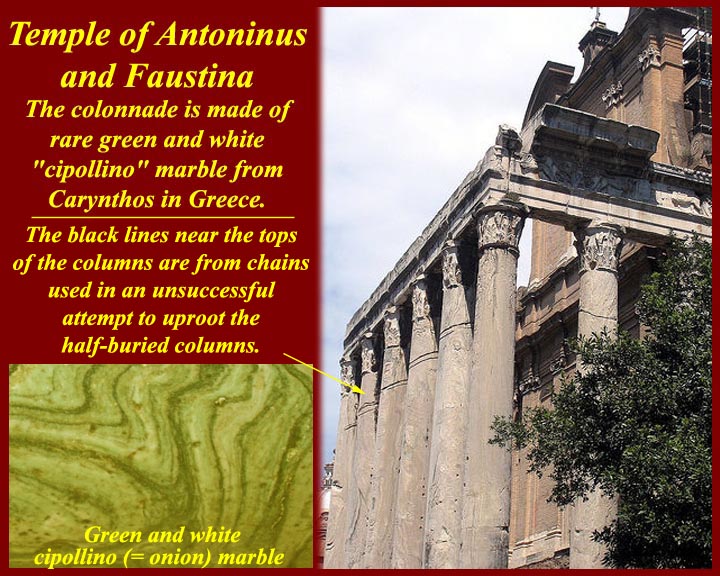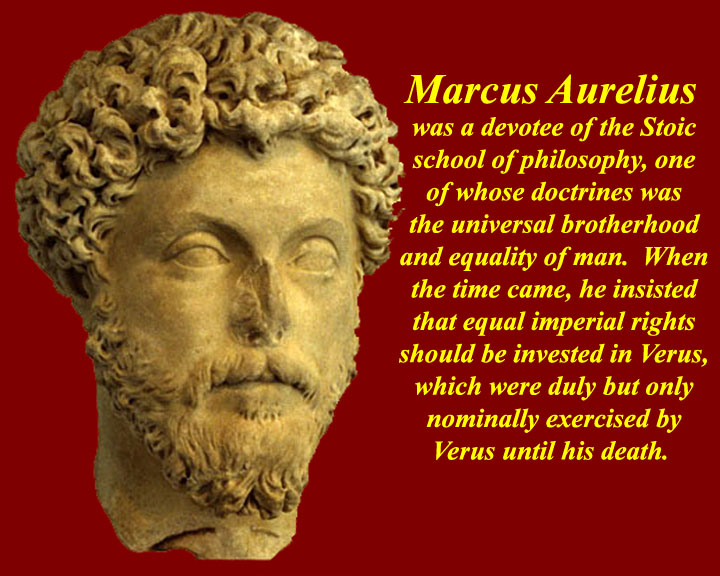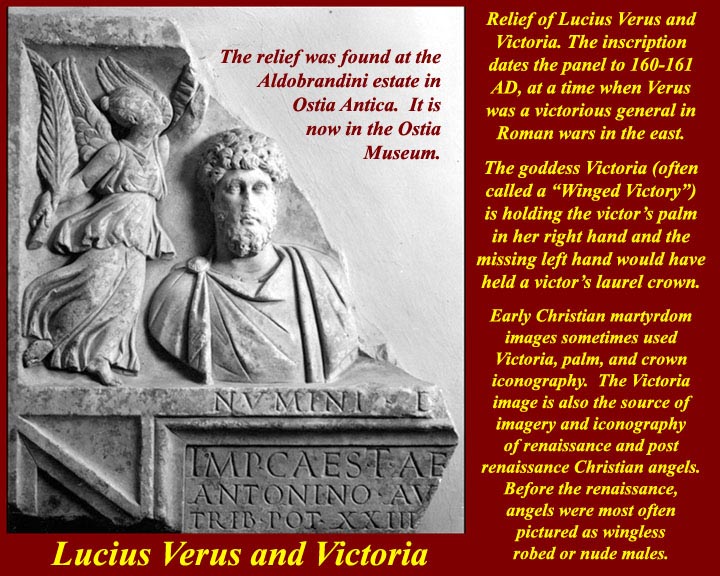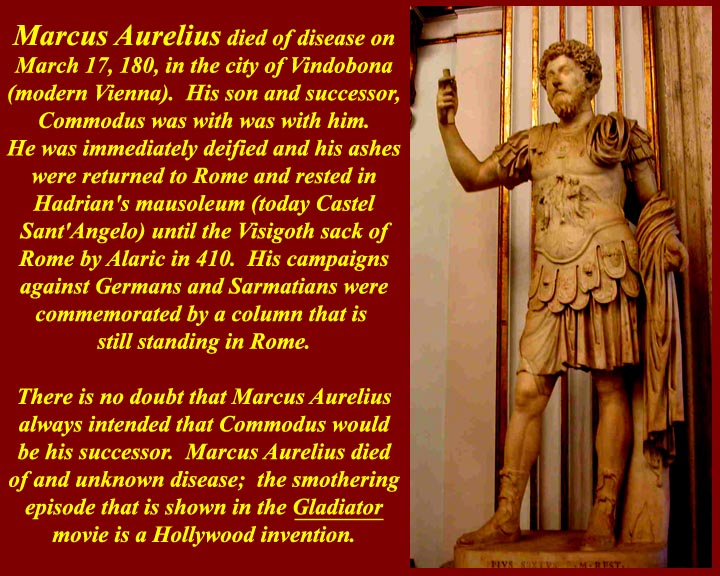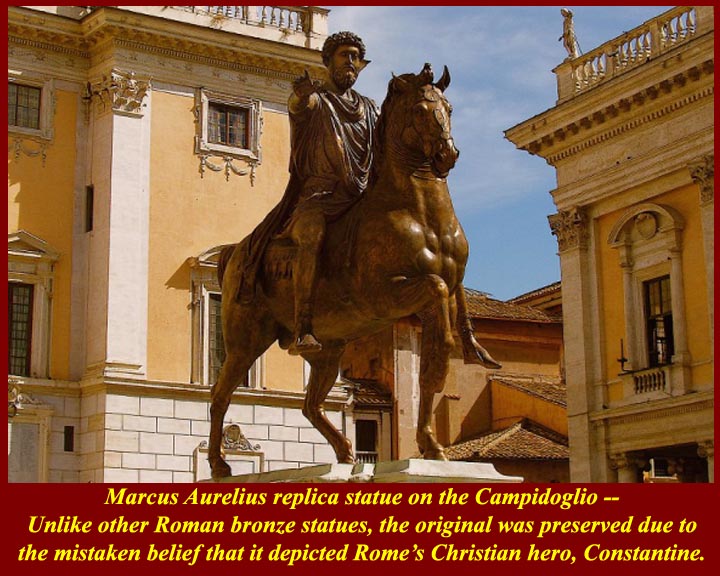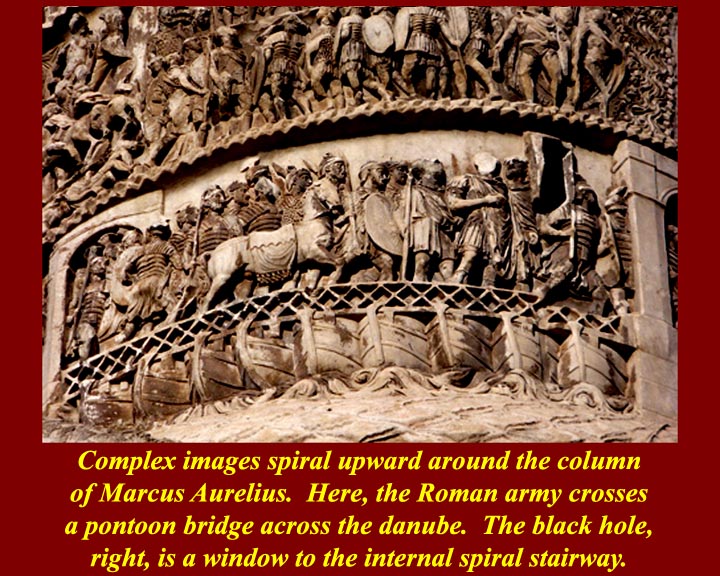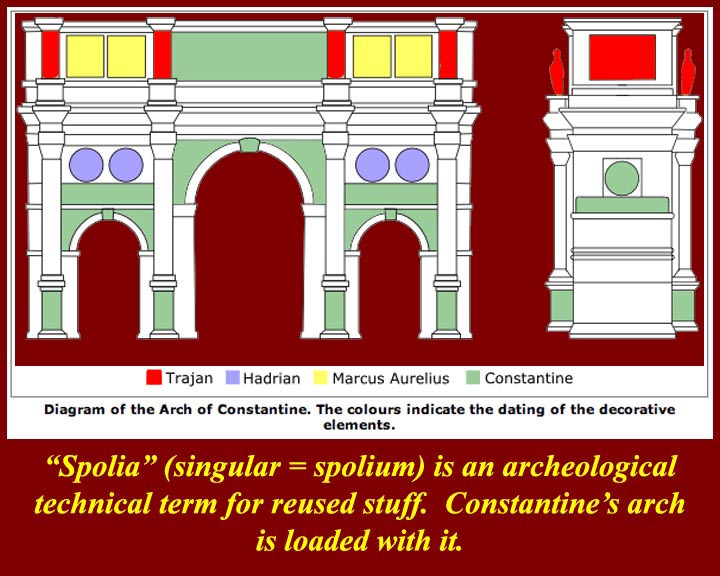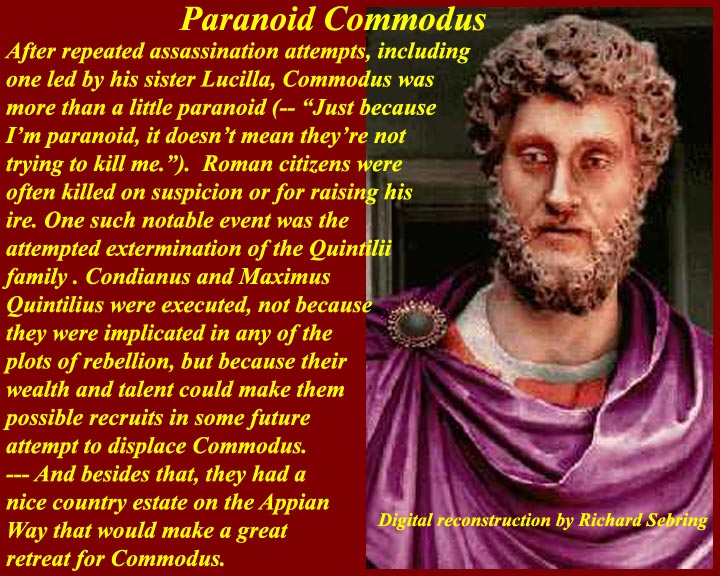Images for ALRI Ancient Rome Unit 7
Flavian and Antonine Emperors
For biographic information on the emperors, go to
http://www.roman-emperors.org/,
or enter an emperor's name at
http://www.wikipedia.org/.
Click on small images or links below to view larger images.
http://www.mmdtkw.org/AU0700NeroSuicide.jpg
Nero, as we have said, committed suicide and ended the Julio-Claudian dynasty.
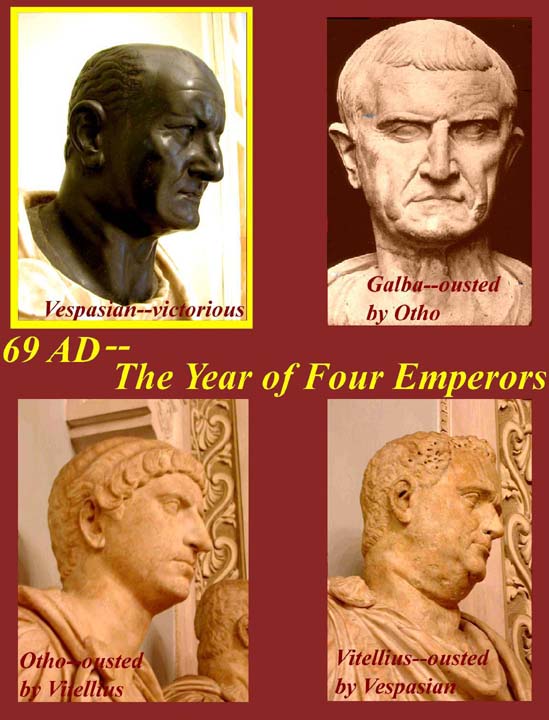
http://www.mmdtkw.org/AU0701FourEmperors69AD.jpg
Nero had several reasons for killing himself, and among them were revolts of several generals who wanted to Replace him. The first to arrive in Rome was Galba (upper right). He was ousted by Otho (lower left), who was, in turn ousted by Vitellius (lower right). While they sequentially fought it out in Rome, Vespasian bided his time in the east, staying in his headquarters in Alexandria while his son, Titus, mopped up the 2nd Jewish Revolt in Jerusalem. They would be the first two emperors of the Flavian dynasty.
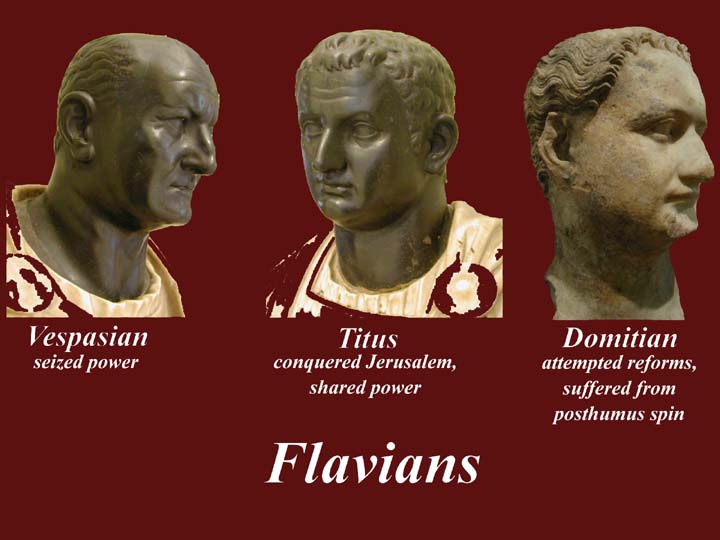
http://www.mmdtkw.org/AU0702Flavians.jpg
http://www.mmdtkw.org/AU0703aFlavians2.jpg
There were, in fact, only three Flavian emperors: Vespasian, Titus, and Domitian, the second son of Vespasian.
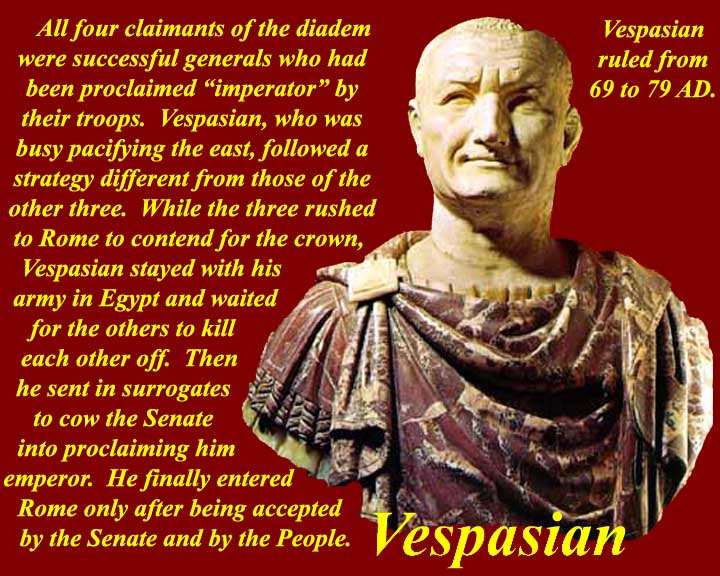
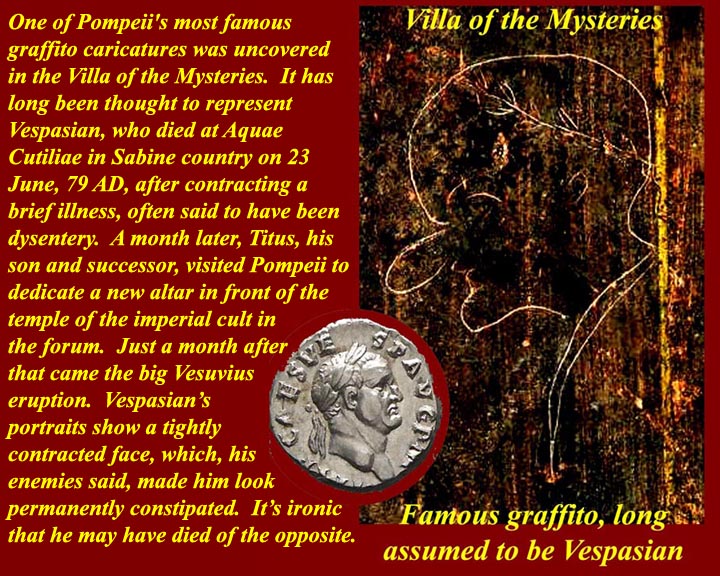
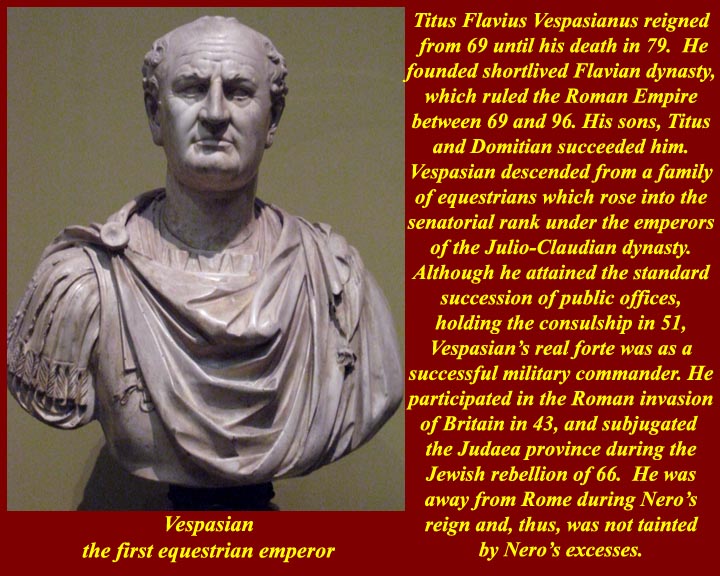
http://www.mmdtkw.org/AU0703bVespasian.jpg
http://www.mmdtkw.org/AU0703cVespasianVillaMysteriesGraffito.jpg
http://www.mmdtkw.org/AU0703dVespasianu.jpg
http://www.mmdtkw.org/AU0703eVespasianCoin.jpg
Vespasian sent surrogates into Rome at the end of the "year of four emperors" (68 AD) to prepare the way for him. After that chaotic year, and especially after Nero's reign, Vespasian was received as a savior. He was an able administrator, a no-nonsense leader, an economic reformer (meaning he cut back on Nero's waste and the corruption that had marked the end of the Julio-Claudians, and he had enough military power behind him to thwart the ambitions of any other pretenders to the imperial mantle -- that meant, to the common people, a welcome period of peace and quiet in the city and the empire. Vespasian ruled for ten years (69 - 79), and, during the last few years, deftly and gradually passed power to Titus.
Historians report that Vespasian ordered the construction of several buildings in Rome. Vespasian helped rebuild Rome after the civil war. He added the temple of Peace and the temple to the deified Claudius. In 75, he dedicated a colossal statue of Apollo (originally a statue that Nero began of himself), and he dedicated a new stage at the theater of Marcellus. He also began construction of the Flavian Amphitheater, which much later was called the Colosseum -- after that colossus of Apollo.
Suetonius claims that Vespasian was met with "constant conspiracies" against him, but only one conspiracy is known specifically. In 78 or 79, Eprius Marcellus and Caecina Alienus attempted to kill Vespasian. Why these men turned against Vespasian is not known, and in fact, between 71 and 79, much of Vespasian's reign is a mystery
In 78, Agricola, who was one of Vespasian's early supporters and then one of his best generals, went to Britain, and both extended and consolidated the Roman dominion in that province, pushing his way into what is now Scotland. On June 23 of the following year, Vespasian died of an intestinal inflammation which led to excessive diarrhea. This was considered ironic, because he had been described as looking like he was permanently constipated. According to Suetonius (Life of Vespasian 23.4), his last words were: Vae, puto, deus fio ("Dammit - I think I'm becoming a god"). He was immediately succeeded by Titus.
For a short biography of Vespasian, see http://www.roman-emperors.org/vespasia.htm or http://en.wikipedia.org/wiki/Vespasian.
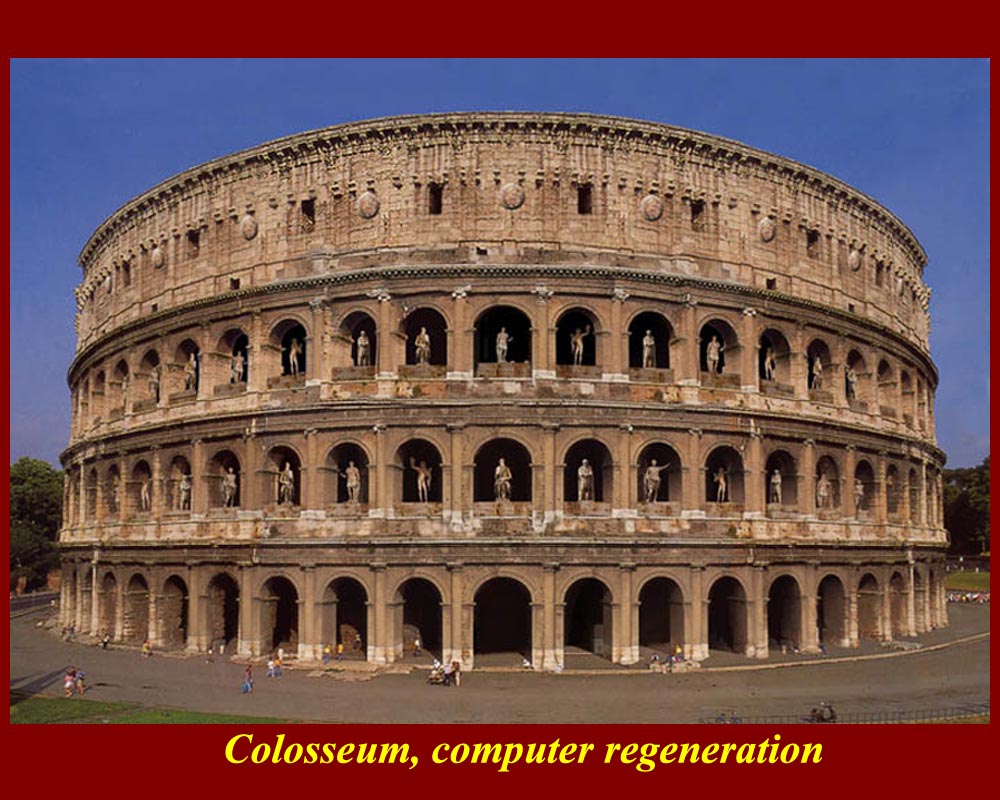
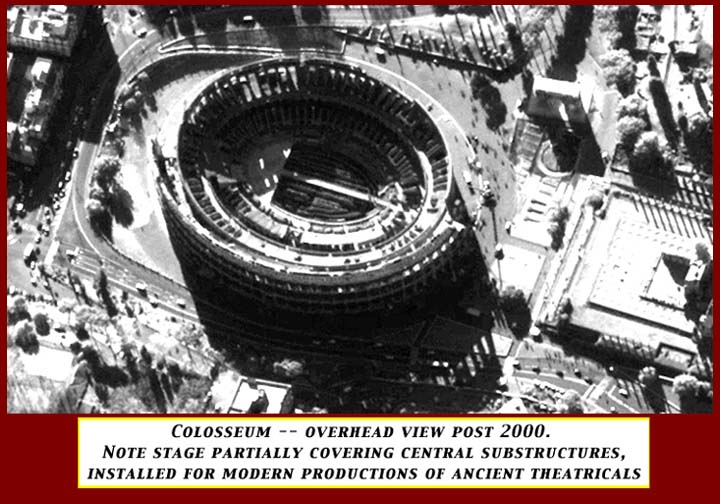
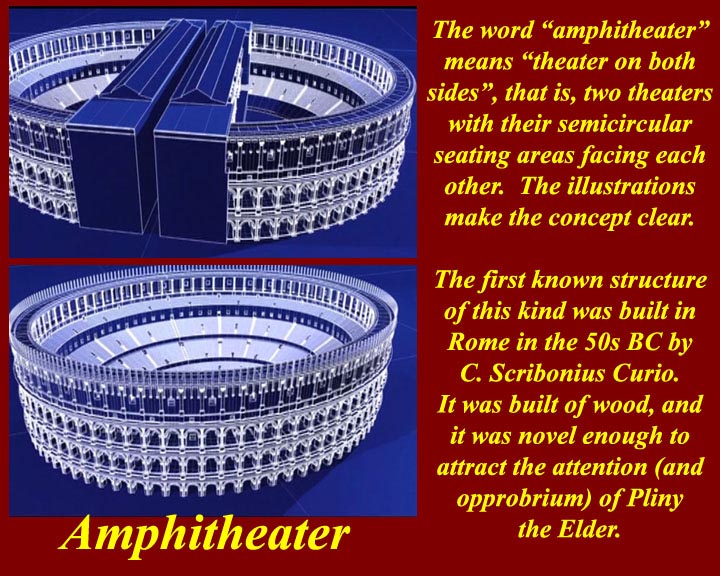
http://www.mmdtkw.org/AU0704aaColosseumCompuGen.jpg
http://www.mmdtkw.org/AU0704aColosseumAero.jpg
http://www.mmdtkw.org/AU0704bColosseum1.jpg
http://www.mmdtkw.org/AU0704cAmphitheaterCurio.jpg
The most impressive relic of Vespasian and the Flavians is, of course, the Colosseum -- the Flavian Amphitheater. For a detailed description, see http://penelope.uchicago.edu/Thayer/E/Gazetteer/Places/Europe/Italy/Lazio/Roma/Rome/_Texts/PLATOP*/Amphitheatrum_Flavium.html,
or http://penelope.uchicago.edu/Thayer/E/Roman/Texts/secondary/SMIGRA*/Amphitheatrum.html, which also has useful illustrations.
(1)(2)
(3)
(4)
(5)
http://www.mmdtkw.org/AU0704dPompeiiAmphitheater_1.jpg
http://www.mmdtkw.org/AU0705Colosseum.jpg
http://www.mmdtkw.org/AU0706ColosseumInt.jpg
http://www.mmdtkw.org/AU0707aColosseum2.jpg
http://www.mmdtkw.org/AU0707bColosseum3.jpg
Image 1 is an artist's rendering of the amphitheater in Pompeii, which, as far as we know, was the first stone amphitheater to be built. Image 5 show some of the mechanical workings of the Colosseum. Note the nets and rollers that surrounded the arena -- designed to prevent wild animals from jumping into the grandstands.
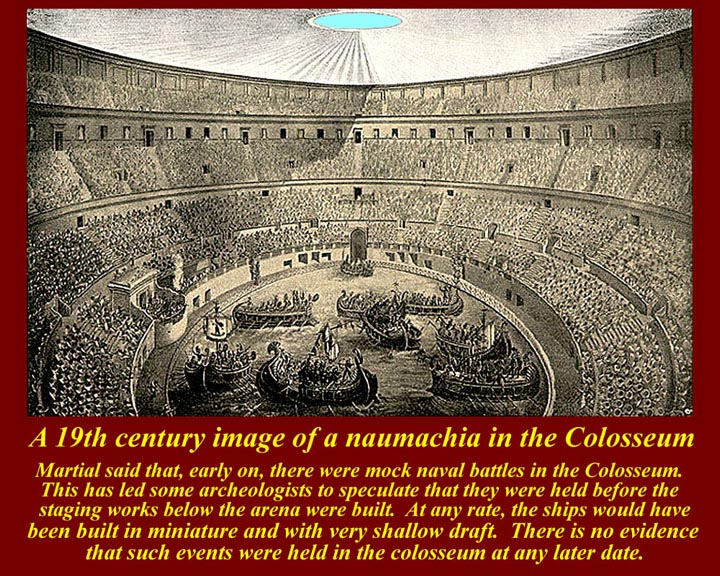
http://www.mmdtkw.org/AU0707cNaumachia3.jpg
http://www.mmdtkw.org/AU0707dNaumachiae.jpg
It has been said, even by ancient historians, that the Colosseum was sometimes flooded for mock naval battles. We don't know if that really ever happened; if it did, it would have been in the early years of the Colosseum, before the substructure were built -- nothing remains of any plumbing to carry water in or out. It may be that wat the ancient historians and writers described took place at "Naumachiae", artificial harbor/stadiums dug out along the Tiber, of which several are known, all on the "Transtiberium" side (west) of the river or in the Campus Martius. The Naumachiae were specifically built for mock naval battles, which were also called naumachiae. For more information, see http://penelope.uchicago.edu/Thayer/E/Gazetteer/Places/Europe/Italy/Lazio/Roma/Rome/_Texts/PLATOP*/Naumachiae.html
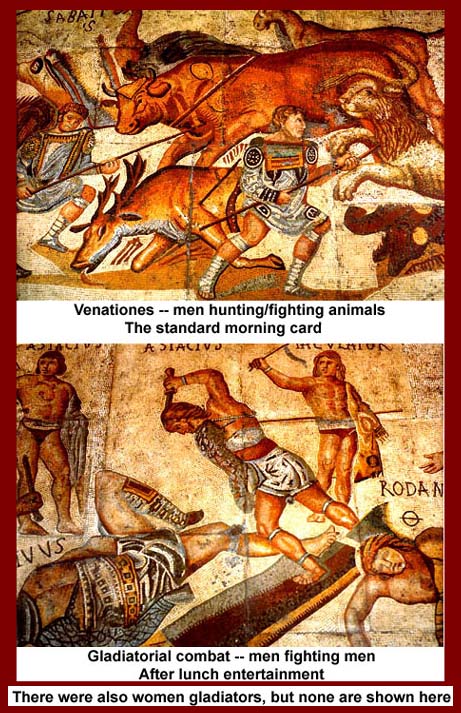
http://www.mmdtkw.org/AU0708aGladiators.jpg
http://www.mmdtkw.org/AU0708bColosseum.jpg
We know what went on in the Colosseum because tickets and playbills survive. The morning show was almost always a venatio or wild animal hunt -- men against beasts -- with occasional beast against beast fights thrown in. After lunch, generally until sunset, it was gladiators. The lunch time program -- least popular, because most spectators went outside to the food stalls during this time -- was when the damnatio ad bestias took place. Criminals, including some Christians, were put in the arena with wild animals. The Christians generally did not put up a fight, so the show was boring. Almost all Christians managed to "render unto Caesar" and avoid martyrdom; the corollary is that you pretty much had to seek martyrdom to achieve it. Statistics vary on how many died: the Catholic church estimates that no more than 10,000 died in all the persecutions throughout the empire. Protestants usually go with a higher number, about 40,000. Estimates of the total Christian population during the period of the persecutions run to many millions. It's also indisputable that, after Christianity was made the state religion, Christians killed many more "heretics" than the pagans ever killed Christians. For information on persecution of and by Christians, see http://en.wikipedia.org/wiki/Persecution_of_religion_in_ancient_Rome.
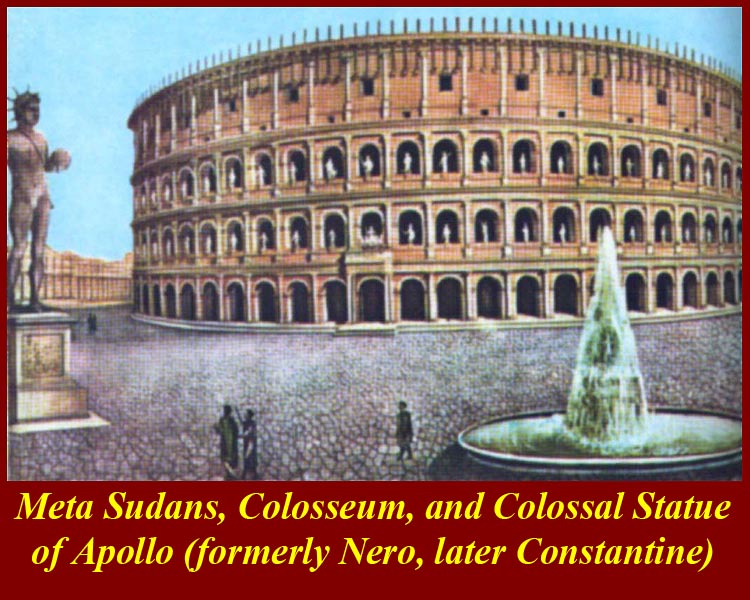
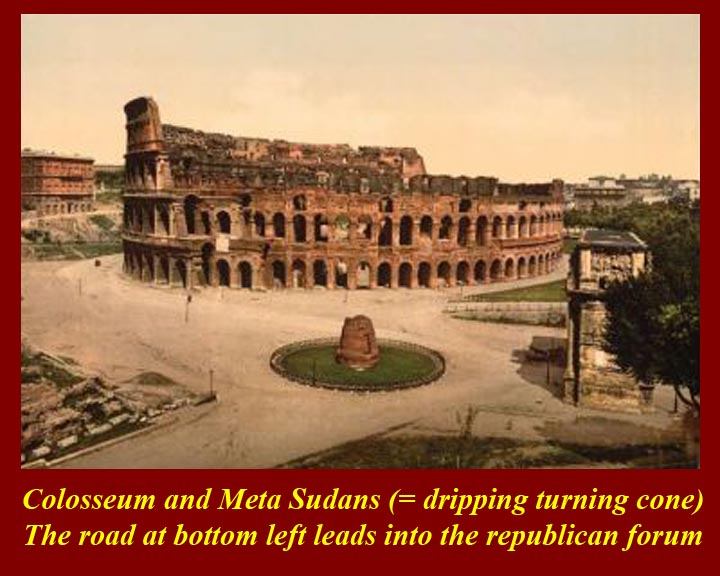
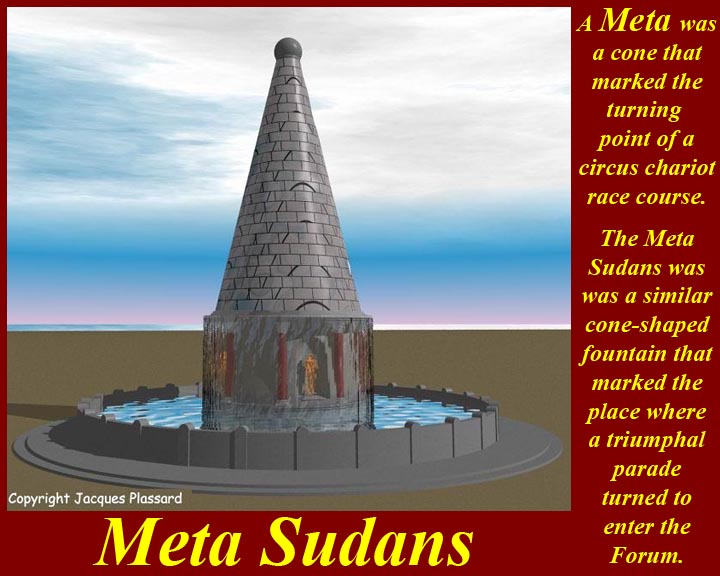
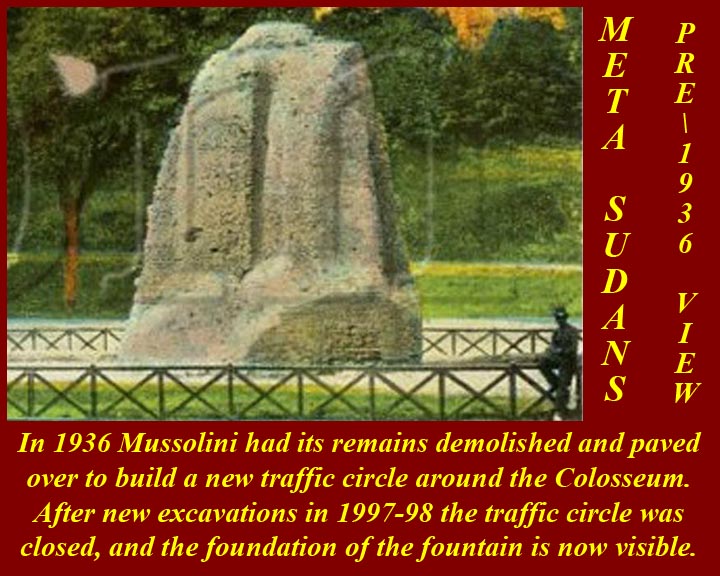
http://www.mmdtkw.org/AU0708cMetaSudans1.jpg
http://www.mmdtkw.org/AU0708dMetaSudans2.jpg
http://www.mmdtkw.org/AU0708eMetaSudans3.jpg
http://www.mmdtkw.org/AU0708fMetaSudans4.jpg
Near the Colosseum, the Flavians also built the Meta Sudans, a cone shaped fountain, which was similar to the metae that marked the turns in chariot racing venues. The fountain served as a marker for the turn of triumphal processions from the Via Triumphalis onto the Via Sacra that ran through the center of the Forum Romanum. At this turning point the procession took on a much more religious significance. It still recognised the Triumphator, but as it proceeded up the Via Sacra it also became a celebration of the offering of the spoils and prisoners of war to the Roman Triad: Jupiter (= "Zeus Pater"), Juno, and Minerva.
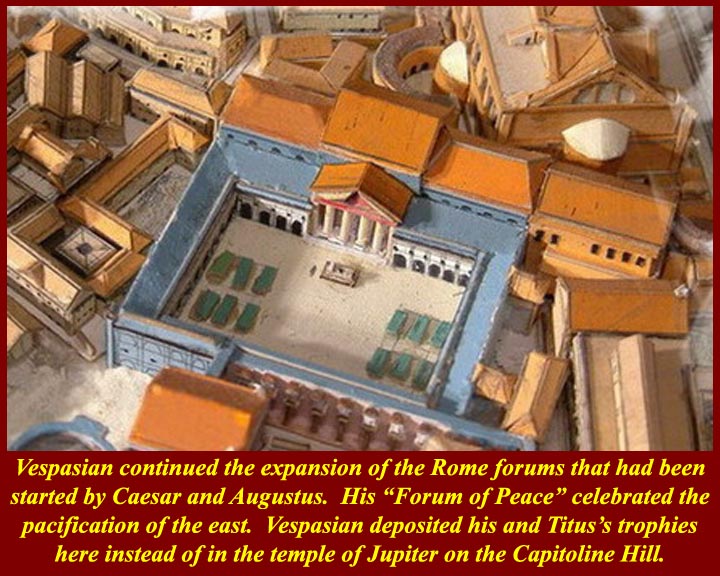
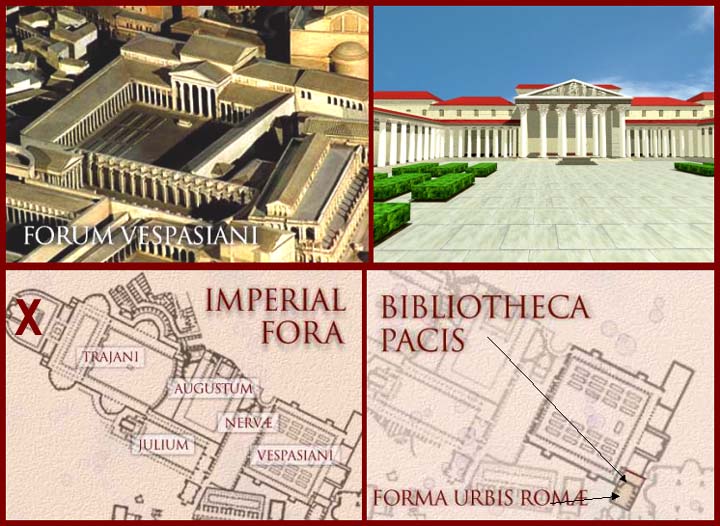
http://www.mmdtkw.org/AU0709aVespasianPeaceForum.jpg
http://www.mmdtkw.org/AU0709bForumPeaceVespasian.jpg
http://www.mmdtkw.org/AU0709cMarblePlan.jpg
Vespasian called his forum the Forum of Peace, a clear reference to his pacification of the chaos following Nero's suicide as well as his and his son's pacification of the east (today's Middle East.) To emphasize the latter, he and his son dedicated the trophies of their war against the Jews in the Templum Pacis that faced into the forum rather than at the traditional site, the temple of Jupiter Optimus Maximus on the Capitoline hill. He deposited most of the trophies and treasures in the bibliotheca pacis adjacent to the Forum of Peace along with numerous sculptures and other art works that had been collected (looted?) in the east. One of the walls of the library (now an exterior wall of the Church of Saints Cosmas and Damien) was later the location of the "Marble Plan" of Rome ("Forma Urbis Romae") emplaced between 203 and 211 AD during the reign of Septimius Severus. For information of Vespasian's Temple and Forum of peace, see
http://penelope.uchicago.edu/Thayer/E/Gazetteer/Places/Europe/Italy/Lazio/Roma/Rome/_Texts/PLATOP*/Templum_Pacis.html
and for information on the Marble Plan, see http://en.wikipedia.org/wiki/Forma_Urbis_Romae
http://www.mmdtkw.org/AU0710AedesDiviClaudius.jpg
The Temple of Deified Claudius was part of the Flavian dynasty's effort to return land appropriated by Nero to public use. To build it, the Flavians destroyed Nero's nymphaeum, a part of his Domus Aurea complex.
http://www.mmdtkw.org/AU0711aaaTitus.jpg
Titus was Vespasian's older son, who had commanded armies for Vespasian in the east and had finished the 2nd Jewish revolt and destroyed the Jewish Temple of Jerusalem. He co-ruled during the last years of Vespasian's reign on a de facto if not de jure basis and peacefully succeeded him when he died of dysentery. Titus, himself, died in September, A.D. 81 after only 26 months in office. Suetonius recorded that Titus died on his way to the Sabine country of his ancestors in the same villa as his father. A competing tradition persistently implicated his brother and successor, Domitian, as having had a hand in the Titus's demise, but the evidence is highly contradictory and any wrongdoing is difficult to prove. Domitian himself delivered the funeral eulogy and had Titus deified. He also built several monuments in honor of Titus and completed the Temple of Vespasian and Titus, changing the name of the structure to include his brother's and setting up his cult statue in the Temple itself.
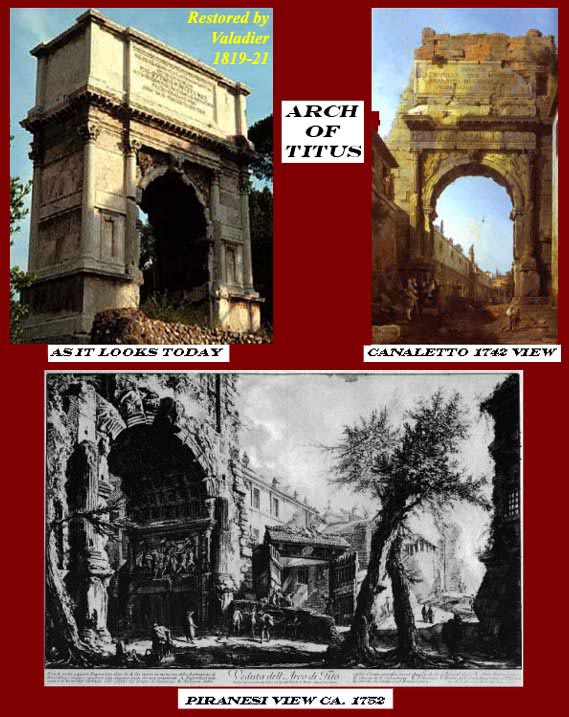
http://www.mmdtkw.org/AU0711aArchTitus.jpg
http://www.mmdtkw.org/AU0711bArchTitus2.jpg
The Arch of Titus in Rome's forum commemorates the dual triumph celebrated by Vespasian and Titus at the end of their Jewish War. The interior reliefs of the arch show two views of the triumphal procession on the Via Sacra through the Forum: one shows the Triumphator (presumed to be Titus rather than Vespasian) in his quadriga -- a four horse chariot; and the other shows troops carrying trophies seized from the Temple of Jerusalem including, prominently, the great seven-branched menorah. The arch as viewed today was heavily restored during the pontificate of Pope Pius VII by Giuseppe Valadier between 1819 and 1821. For more on the Arcus Titi, see http://penelope.uchicago.edu/Thayer/E/Gazetteer/Places/Europe/Italy/Lazio/Roma/Rome/_Texts/PLATOP*/Arcus_Titi.html
http://www.mmdtkw.org/AU0711bDestroyJerusalemTemple.jpg
According to Jusephus (a conquered Jewish general who became a Roman and wrote a history called The Jewish Wars) the Jewish temple was burned and all those who took refuge there were slaughtered by Titus. For more information on Josephus, see http://en.wikipedia.org/wiki/Josephus. For the entire Jewish Wars by Josephus in English, see http://www.ccel.org/j/josephus/works/JOSEPHUS.HTM
http://www.mmdtkw.org/AU0711cTempleVespasian.jpg
Titus began construction of this temple, but it was finished by his younger brother, Domitian, who dedicated it both to Vespasian, their father, and to Titus.
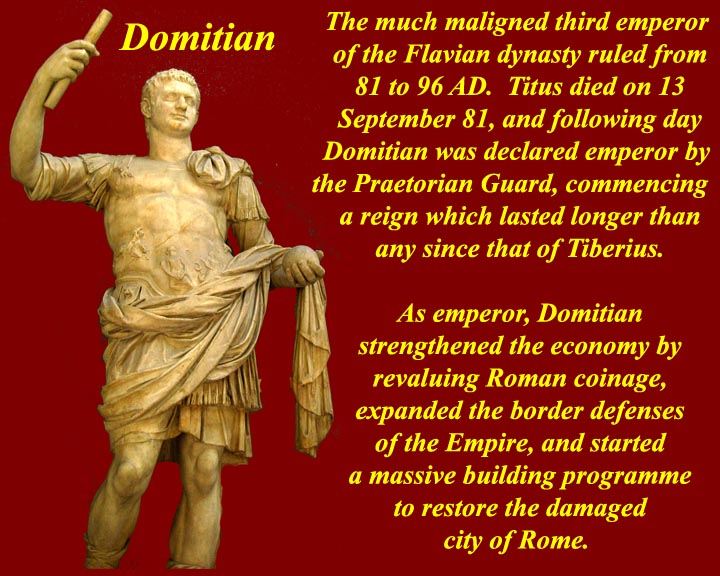
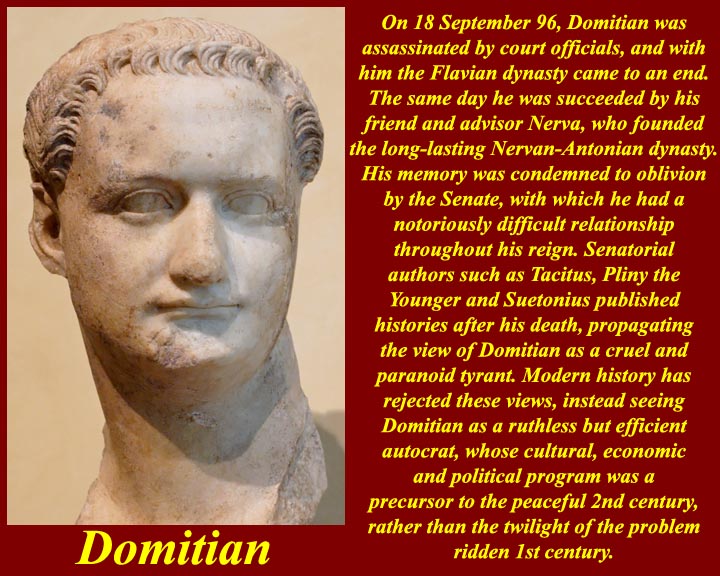
http://www.mmdtkw.org/AU0712aStatueDomitian.jpg
http://www.mmdtkw.org/AU0712bDomitianMaligned.jpg
http://www.mmdtkw.org/AU0712cDomitanSenatePraetorians.jpg
"....Domitian's autocratic tendencies meant that the real seat of power during his reign resided with his court. The features typically associated with later courts - a small band of favored courtiers, a keen interest in the bizarre and the unusual (e.g., wrestlers, jesters, and dwarfs), and a highly mannered, if somewhat artificial atmosphere, characterized Domitian's palace too, whether at Rome or at his Alban villa, some 20 kilometers outside of the capital. Courtiers included family members and freedmen, as well as friends (amici), a group of politicians, generals, and praetorian prefects who offered input on important matters. Reliance upon amici was not new, yet the arrangement underscored Domitian's mistrust of the aristocracy, most notably the senate, whose role suffered as Domitian deliberately concentrated power in the hands of few senators while expanding the duties of the equestrian class. Senatorial grievances were not without basis: at least 11 senators of consular rank were executed and many others exiled, ample attestation of the emperor's contempt for the body and its membership. The senate's enthusiastic support for the damning of Domitian's memory, therefore, came as no surprise. Nevertheless, the situation must be placed in its proper context. By comparison, the emperor Claudius (A.D. 41-54) executed 35 senators and upwards of 300 equestrians, yet he was still deified by the senate! Domitian's mistake was that he made no attempt to mask his feelings about the senate. Inclined neither by nature nor by conviction to include the body in his emperorship, he treated the group no differently than any other. Revenge would come in the form of an aristocratically based literary tradition that would miss no opportunity to vilify thoroughly both emperor and his rule.
Death and Assessment....
"On 18 September, A.D. 96, Domitian was assassinated and was succeeded on the very same day by M. Cocceius Nerva, a senator and one of his amici. The sources are unanimous in stressing that this was a palace plot, yet it is difficult to determine the level of culpability among the various potential conspirators.
"In many ways, Domitian is still a mystery -- a lazy and licentious ruler by some accounts, an ambitious administrator and keeper of traditional Roman religion by others. As many of his economic, provincial, and military policies reveal, he was efficient and practical in much that he undertook, yet he also did nothing to hide the harsher despotic realities of his rule. This fact, combined with his solitary personality and frequent absences from Rome, guaranteed a harsh portrayal of his rule. The ultimate truths of his reign remain difficult to know." (Extracted from Domitian's bio at http://www.roman-emperors.org/domitian.htm.)
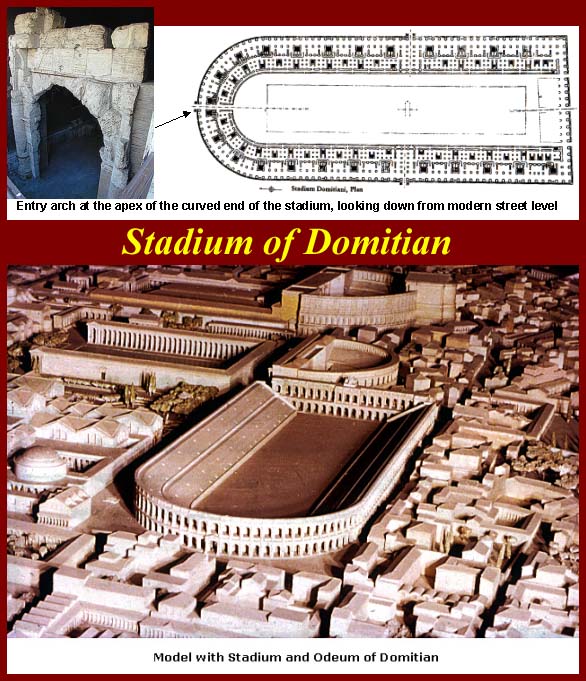
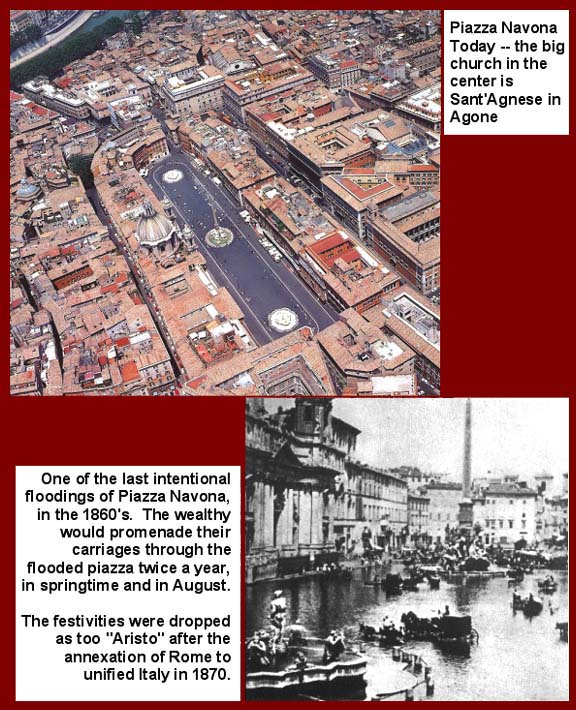
http://www.mmdtkw.org/AU0713PiazzaNavona1.jpg
http://www.mmdtkw.org/AU0714aPiazzaNavona2.jpg
http://www.mmdtkw.org/AU0714bDomitanStadiusGreekSports.jpg
The most visible and famous relic of Domitian's 15 year reign (81 to 96 AD) is Rome's present Piazza Navona, which was built as a stadium for Greek style sports. Domitian was reportedly averse to the bloodshed of the gladiatorial games and the beast fights and also wanted to provide Romans with a more civilized alternative. His Greek games ("Agone") are said to have lasted for only one season, during which naked women athletes were added to the traditional naked men; even that did not improve the gate, and the next season the gladiators took over the venue.
Piazza Navona is a city square in Rome, Italy. It follows the plan of an ancient Roman circus, the 1st century Stadium of Domitian,[1] where the Romans came to watch the agones ("games"): It was known as 'Circus Agonalis' (competition arena). It is believed that over time the name changed to 'in agone' to 'navone' and eventually to 'navona'.
Defined as a public space in the last years of 15th century, when the city market was transferred to it from the Campidoglio, the Piazza Navona is now the pride of Baroque Roman art history. It features sculptural and architectural creations by Gian Lorenzo Bernini, whose famous Fontana dei Quattro Fiumi (Fountain of the Four Rivers, 1651) stands in the center; by Francesco Borromini and Girolamo Rainaldi, who designed the church of Sant'Agnese in Agone; and by Pietro da Cortona, who painted the galleria in the Pamphilj palace.
The market was again moved in 1869 to the Campo de' Fiori. The piazza long hosted theatrical shows and horse races. From 1652 until 1866, when the festival was suppressed, it was flooded on every August Saturday and Sunday for elaborate celebrations of the Pamphilj family.
The Piazza Navona contains two additional fountains, sculpted by Giacomo della Porta: the Fontana di Nettuno (1574), located at the northern area of the piazza; and the Fontana del Moro (1576), located at the southern end.
Piazza Navona remains today the haunt of tourists, artists, and street performers and hosts the annual Rome Christmas Fair. The holiday bazaar starts December 1st and lasts through January 6th when the the good witch, Befana, arrives with gifts for the children. January 6th is the day that it's said the Three Wise Men arrived to greet Jesus, and is celebrated in Italy with the exchange of gifts.
http://www.mmdtkw.org/AU0714cOdeonDomitian.jpg
Just off the southern end of his stadium, Domitian built an Odeon, a small covered theater for the singing of odes. Traditionally, the composer would accompany himself on the lyre.
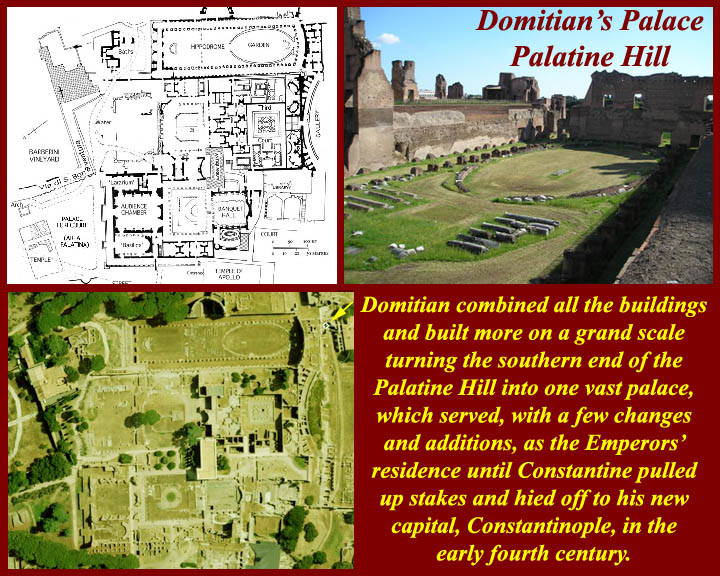
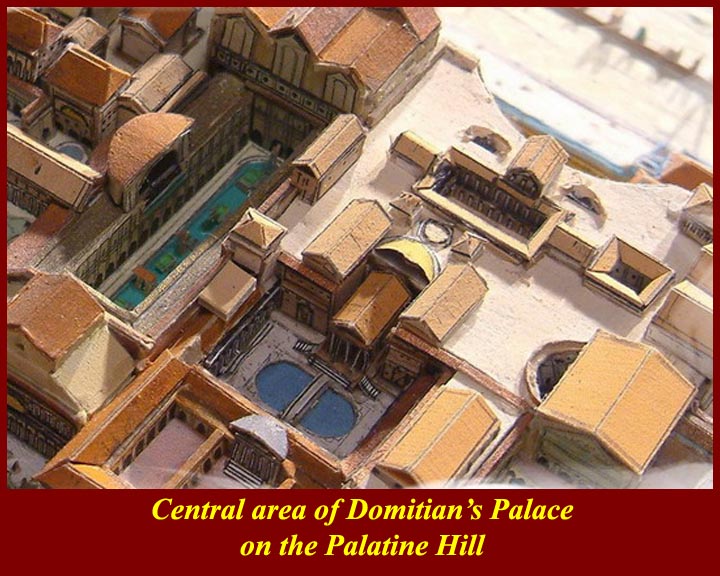
http://www.mmdtkw.org/AU0715aDomitianPalace1.jpg
http://www.mmdtkw.org/AU0715bDomitianPalace2.jpg
http://www.mmdtkw.org/AU0715cDomitianPalaceDining.jpg
The imperial palace on the Palatine Hill was the largest of Domitian's many construction projects in Rome. The city was still recovering from the fire of 64 AD during Nero's reign when another devastating blaze struck during the reign of Titus in 80 AD. This gave Domitian wide scope in his rebuilding and reconstruction efforts. Most of what can now be seen on the Palatine are massive ruins of his Domus Augustana, the House of the Augustuses. See http://www.roman-empire.net/tours/rome/palatine.html. and http://www.dartmouth.edu/~classics/rome2005/updates/week9_10/nov15.html.
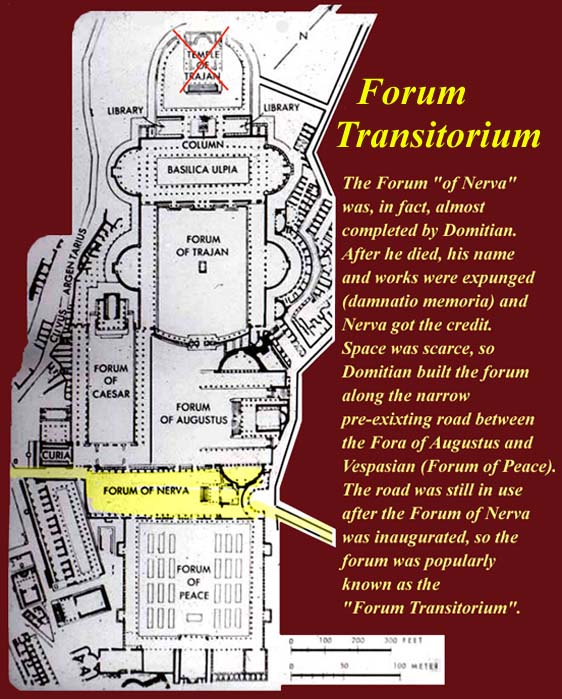
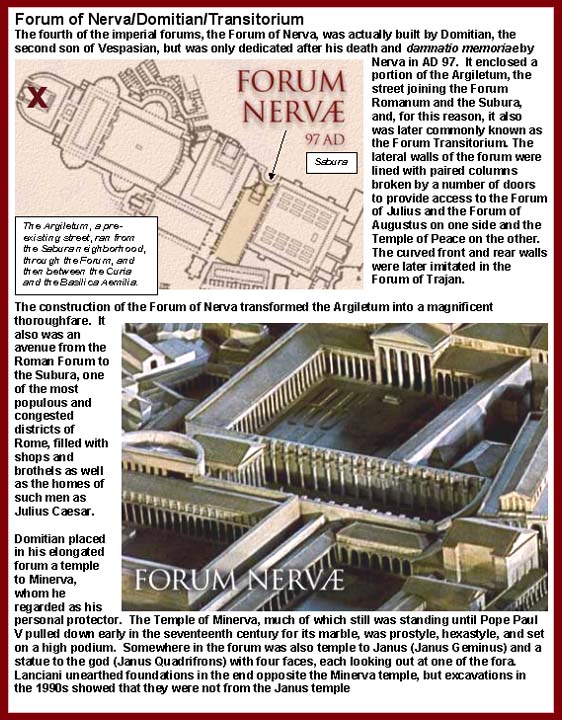
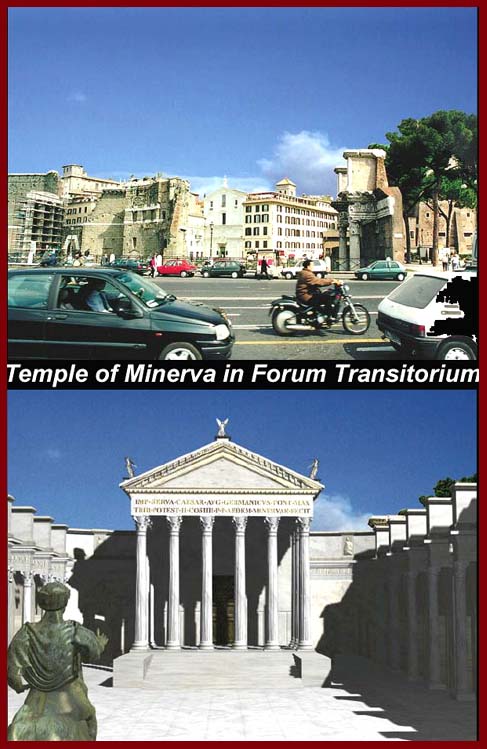
http://www.mmdtkw.org/AU0716aForumNerva1.jpg
http://www.mmdtkw.org/AU0716ForumNerva2.jpg
http://www.mmdtkw.org/AU0717NervaForum3.jpg
http://www.mmdtkw.org/AU0718ForumNerva4.jpg
Domitian had almost completed his forum on a narrow strip of land between the Forum of Augustus and the Forum of Peace (of Vespasian) when he was assassinated in a palace coup. His successor added the very minor finishing touches and got credit for the project -- Domitian was the the object of an official Damnatio Memoriae by the Senate -- his images, inscriptions, acts, and projects were to be condemned and forgotten and, if physical structures remained, ascribed to others. The Flavian dynasty ended with the death of Domitian just as the Julio-Claudians had ended with the death of Nero. Both closers were formally condemned by the Senate to Damnatio Memoriae -- and both may well have deserved the dishonor, although it's likely that they weren't (quite) as bad as their detractors said they were. We don't know the circumstances of Domitian's assassination, but we do know he was immediately replaced by Nerva, a Senator who had served
Nero, Vespasian, Titus, and finally Domitian before Domitian became suspicious of him (and almost everyone else). We don't know if he was in hiding before Domitian's assassination.
http://www.mmdtkw.org/AU0719AdoptiveAntonineEmps.jpg
Nerva's short reign ushered in the 80 year long period of the "Five Good Emperors" (96 to 169 AD). They are also sometimes called the Antonine dynasty, although Commodus, the last of the Antonines, was not considered good at all by history. The Seventh of the pictured "Antonines" was Verus. He never reigned independently, sharing office, but always in a subordinate role, with Marcus Aurelius fro 161 through 169 when he died en route to a German war. He's in the middle of the lower row.
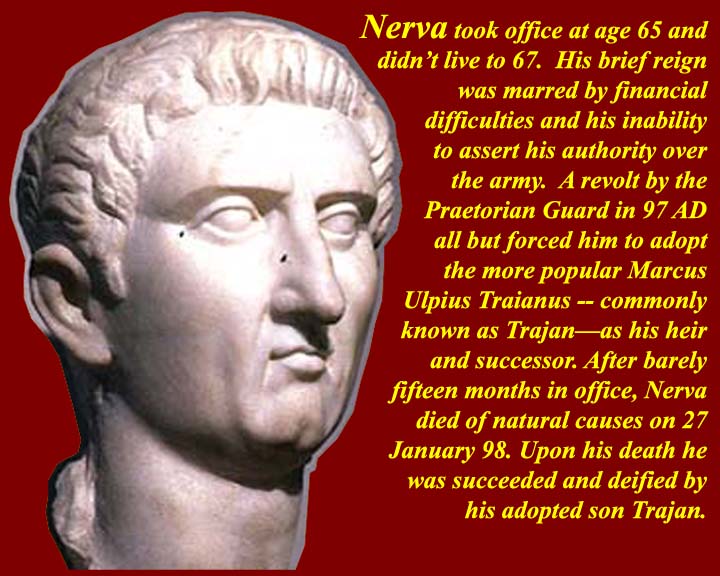
http://www.mmdtkw.org/AU0720aNerva1.jpg
http://www.mmdtkw.org/AU0720bNerva2.jpg
Although short, the reign of Marcus Cocceius Nerva (A.D. 96-98) is pivotal. The first of Edward Gibbon's so-called "Five Good Emperors," Nerva is credited with beginning the practice of adopting his heir rather than selecting a blood relative. For this reason the Antonines are also sometimes called the "Adoptive" emperors. Claimed as an ancestor by all the emperors down to Severus Alexander, he has traditionally been regarded with much good will, most of this simply because he was not his predecessor, Domitian.
It was not long before the assassination of Domitian came to work against the new emperor. Dissatisfied that Domitian had not been deified after his death, the praetorian guards mutinied under Casperius Aelianus in October 97. (At the time of a deification, the Praetorians could expect a cash "donatio", which, of course, they had not received because Domitian hadn't been deified.) Taking the emperor as hostage, they demanded that Nerva hand over Domitian's murderers. The emperor not only relented, but was forced to give a public speech of thanks to the mutineers for their actions. His authority compromised, Nerva used the occasion of a victory in Pannonia over the Germans in late October, 97 to announce the adoption of the popular Marcus Ulpius Traianus, governor of Upper Germany, as his successor.
On January 1, 98, the start of his fourth consulship, Nerva suffered a stroke during a private audience. Three weeks later he died at his villa in the Gardens of Sallust. (Part of the Gardens is now the compound of the American Embassy in Rome. See http://www.mmdtkw.org/VCryptoporticusSallustiani.html.)
From his headquarters at Cologne, Trajan insisted that Nerva's ashes be placed in the mausoleum of Augustus and asked the senate to vote on his deification. We are further told that he dedicated a temple to Nerva, yet no trace of it has ever been found. Nor was a commemorative series of coins issued for the Deified Nerva in the wake of his death, but only ten years later.
Nerva's reign was more concerned with the continuation of an existing political system than with the birth of a new age. Indeed, his economic policies, his relationship with the senate, and the men whom he chose to govern and to offer him advice all show signs of Flavian influence. In many respects, Nerva was the right man at the right time. His immediate accession following Domitian's murder prevented anarchy and civil war, while his age, poor health and moderate views were perfect attributes for a government that offered a bridge between Domitian's stormy reign and the emperorships of the stable rulers to follow.
Nerva's bio, from which most of the above is excerpted, is at http://www.roman-emperors.org/nerva.htm.
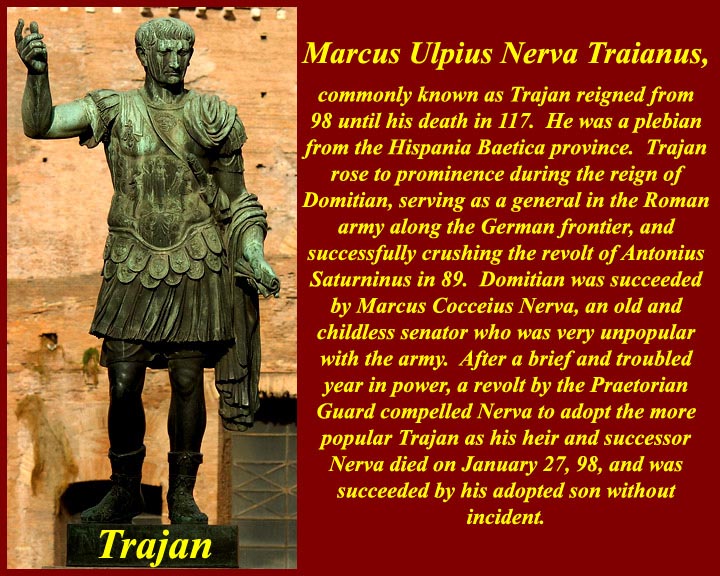
http://www.mmdtkw.org/AU0721aTrajan.jpg
http://www.mmdtkw.org/AU0721bTraianus.jpg
"During a happy period of more than fourscore years, the public administration was conducted by the virtue and abilities of Nerva, Trajan, Hadrian, and the two Antonines. It is the design of this and of the two succeeding chapters to describe the prosperous condition of their empire, and afterwards, from the death of Marcus Antoninus, to deduce the most important circumstances of its decline and fall, a revolution which will ever be remembered and is still felt by the nations of the earth."
This is perhaps the most important and best known of all Edward Gibbon's famous dicta about his vast subject, and particularly that period which he admired the most.
It was a concatenation of chance and events which brought to the first position of the principate five men, each very different from the others, who each, in his own way, brought integrity and a sense of public duty to his tasks. Nerva's tenure was brief, as many no doubt had expected and hoped it would be, and perhaps his greatest achievement was to choose Trajan as his adoptive son and intended successor. It was a splendid choice. Trajan was one of Rome's most admirable figures, a man who merited the renown which he enjoyed in his lifetime and in subsequent generations.
Nerva was quickly succeeded by Trajan. But ---
The sources for the man and his principate are disappointingly skimpy.
From his bio, which is at http://www.roman-emperors.org/trajan.htm.
Trajan was Nerva's governor
of
Germania superior, with his headquarters at Moguntiacum
(Mainz), when
Hadrian (who would ultimately be Trajan's successor) brought
him the
news in autumn 97 that he had been adopted by the emperor
Nerva, as
co-ruler and intended successor. Already recipient of
the title
imperator and possessor of the tribunician power, when Nerva
died on
January 27, 98, Trajan became emperor in a smooth transition
of
power. The chief feature of Trajan's administration was
his good
relations with the senate, which allowed him to accomplish
whatever he
wished without general opposition. His auctoritas was more
important
than his imperium.
Trajan's reign stretched from 98 to 117 AD. His bio is at http://www.roman-emperors.org/trajan.htm (which includes an account of his Dacian wars, images of which are carved on Trajan's column still standing in Rome's imperial forums.
Note that in English we usually spell Trajan's name using a < j > as the letter in the middle. This causes us to vocalize the < j > sound as we vocalize it in English. But the < j > is really an < i >, so the ancient Romans would have said it more like < Trayanus >.
Trajan's reign stretched from 98 to 117 AD. His bio is at http://www.roman-emperors.org/trajan.htm (which includes an account of his Dacian wars, images of which are carved on Trajan's column still standing in Rome's imperial forums.
Note that in English we usually spell Trajan's name using a < j > as the letter in the middle. This causes us to vocalize the < j > sound as we vocalize it in English. But the < j > is really an < i >, so the ancient Romans would have said it more like < Trayanus >.
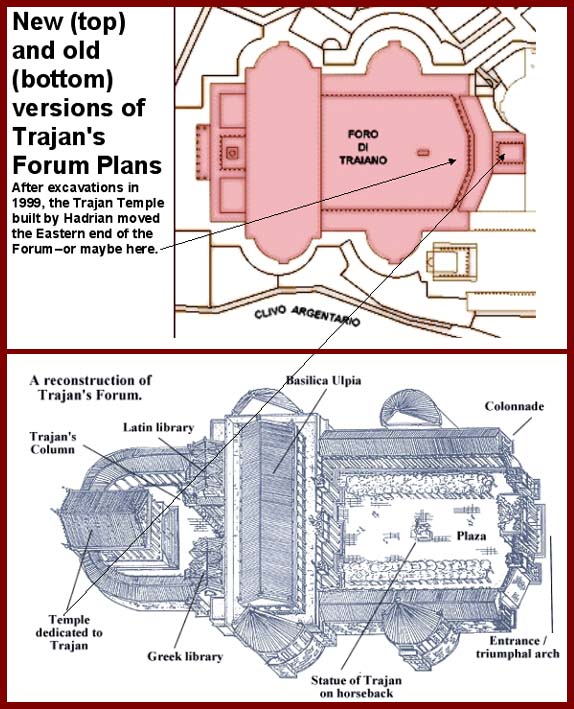
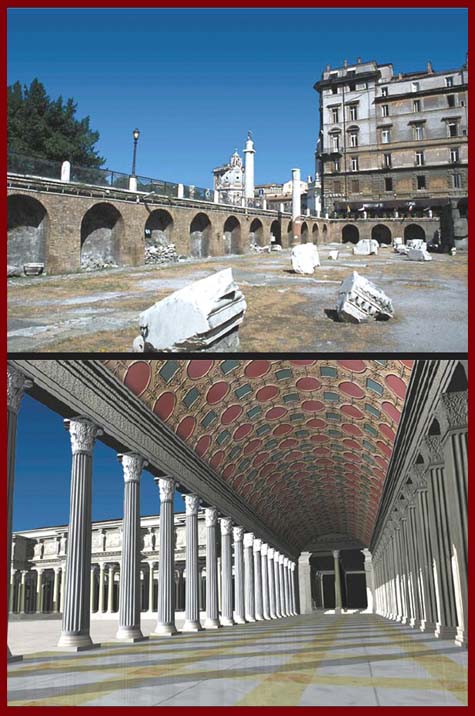
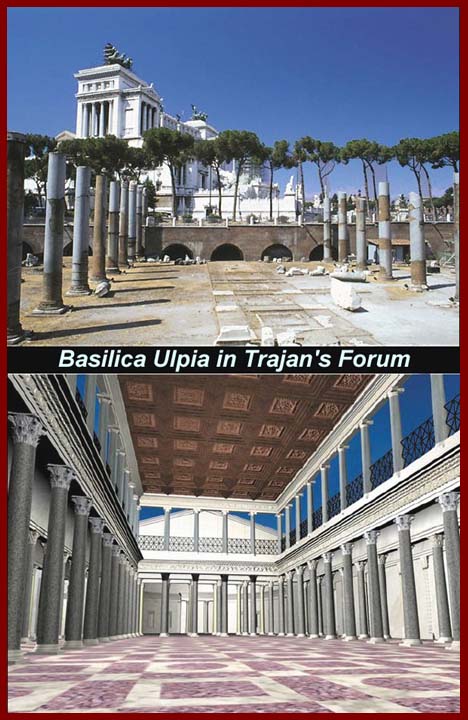
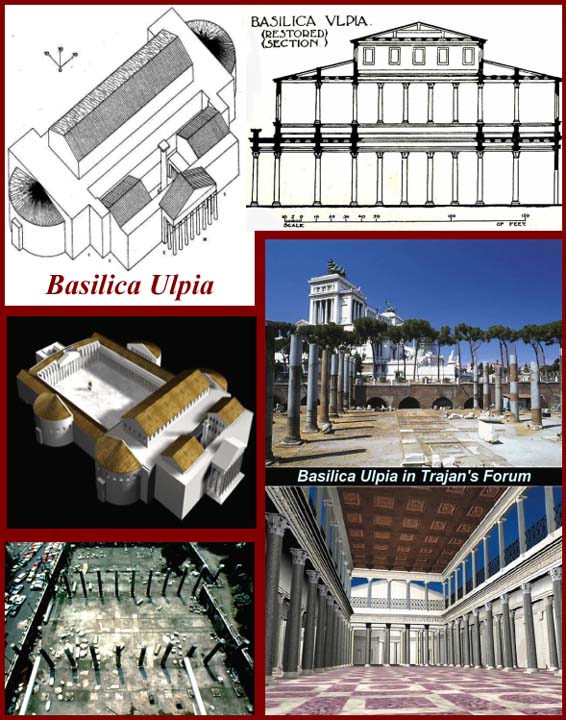
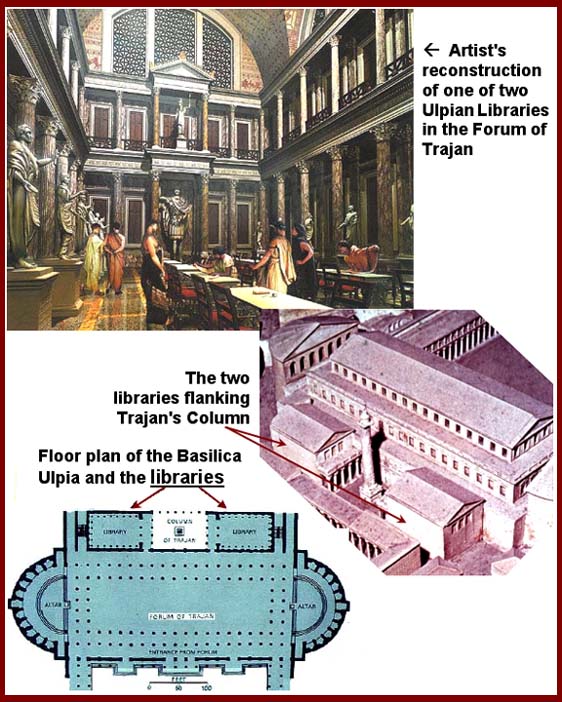
http://www.mmdtkw.org/AU0722aTrajForumNewPlan.jpg
http://www.mmdtkw.org/AU0722bTrajForum.jpg
http://www.mmdtkw.org/AU0722cBasUlpia.jpg
http://www.mmdtkw.org/AU0723BasiUlpia.jpg
http://www.mmdtkw.org/AU0724TrajanLibrary.jpg
http://www.mmdtkw.org/AU0725TrajForColumn.jpg
Trajan's forum is the largest of the imperial forums, and with the adjacent market, built at the same time occupies the northwest corner of the whole Roman forum area. In order to make space for Trajan's forum, the southeast end of the Quirinale Hill was removed -- the debris was dumped outside the city. The structures of the market serve as vast buttresses, which, over the centuries, have supported the excavated edge of the Quirinale. The height of Trajan's Columns (see below) is said to be the same as the height of that part of the Quirinale Hill that was where the Column stands. Trajan's forum was the site of a temple dedicated to Trajan, but its location is not really known. It was formerly thought to lie at the northwest end of forum under two churches and another building beyond them, but 21st century excavations have revealed only and entranceway to the forum. Some of Rome's archaeologist now believe the temple may have stood at the other end of Trajan's forum, but, again, evidence has been hard to find. The largest structure in the forum, and the largest basilica in Rome was the Basilica Ulpia (named after the gens Ulpia in which Trajan was born). Its ruins and artists and computer reconstructions are shown in the images above.
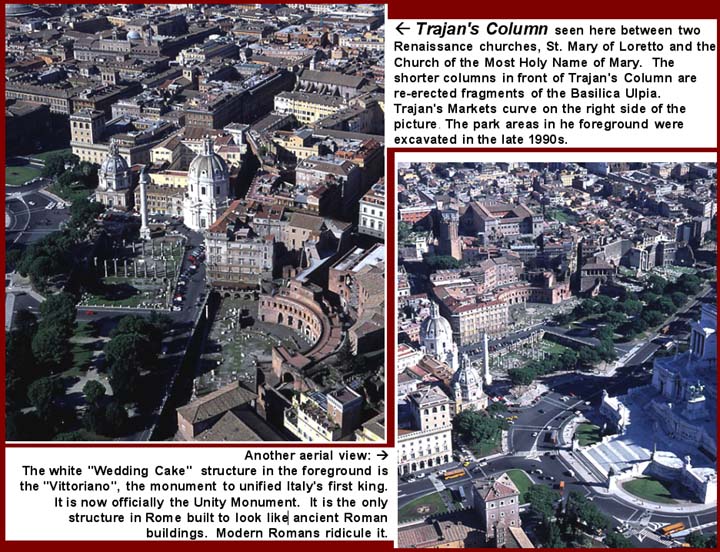
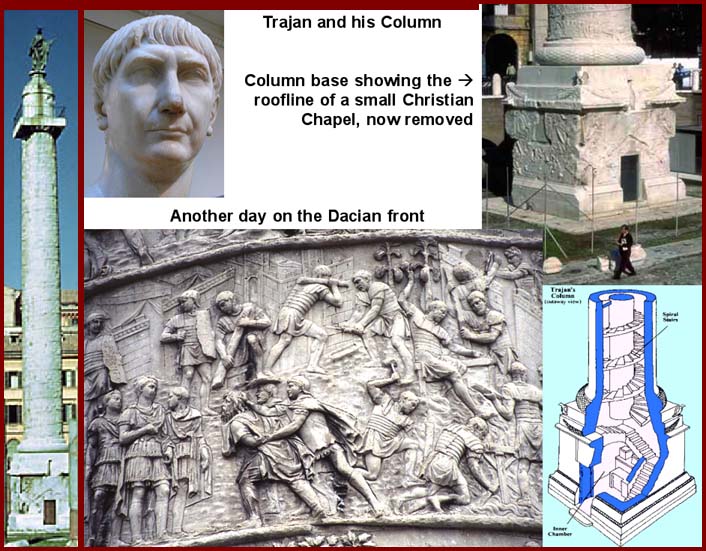
http://www.mmdtkw.org/AU0726TrajCol2.jpg
http://www.mmdtkw.org/AU0727TrajCol.jpg
http://www.mmdtkw.org/AU0727xBeneventumArchTrajan.jpg
Trajan's column is covered with relief images of Trajan's two campaigns (101/102 and 106 AD) against the Dacians and their ruler "Decabalus" -- his name is in quotes because there's an even chance that Decabalus is a Latinization of a title which meant "Ruler/leader of the Dacians". There are hundreds of individuals, images of ceremonies and actions and of forts, towers, bridges, etc. Because of the Roman stone carver's attention to detail, the column is one of the premier sources of information on the Roman military of this period. Note that "stone carver's" in the previous sentence is in the singular; many experts on Roman stone sculpture believe that one man did all the reliefs on the column. It is apparent, because of distortions in the work at the bottoms and tops of the column drums (= stone cylinders that made up the column) that the drums were emplaced and carved sequentially in situ. The statue that now is at the top of the column is of St. Peter. According to coins depicting the column, it was originally topped with a statue of a bird, possibly an eagle, and later by a heroic nude statue of Trajan himself which disappeared in the Middle Ages. In 1588, it was replaced by the statue of St. Peter commissioned by Pope Sixtus V. Like other ancient sculptures in Rome, the reliefs on Trajan's columns were originally brightly painted. A very good internet site for exploration of Trajan's column is at http://www.stoa.org/trajan/.
The civilian counterpart of the Trajan's Column in Rome is his triumphal arch over the Via Appia at Beneventun, which shows Trajan's civic activities in Rome on its northwest face and similar activities outside of Rome on its southeast side. Its detail is similar to the detailed work on the column, and it is similarly useful for study of the civilian side of imperial activities of the time. For views of the individual reliefs on the arch, go to http://www.dl.ket.org/latinlit/historia/empire/beneventum/01benetourbig.htm; click on the "NEXT IMAGE " links on the bottom of this and succeeding pages.
For more Trajan images, see
https://oncourse.iu.edu/access/content/user/leach/www/c414/trajport.html
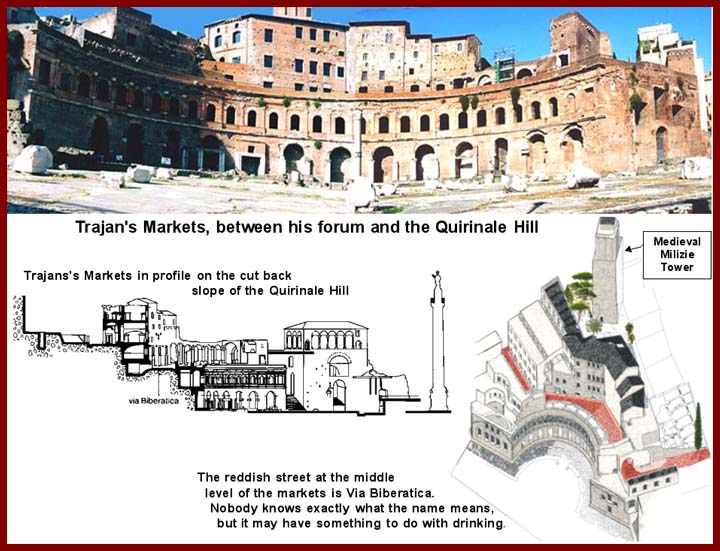
http://www.mmdtkw.org/AU0728TrajanMarket.jpg
http://www.mmdtkw.org/AU0729MaketsTraj.jpg
Yes, its the first known purpose-built shopping mall; it even had an upper level "food court" called the Via Biberatica -- the < bib > in the street's name is from the Latin verb that meant < to drink >. Its the same root from which we get the English word "imbibe". The real purpose of Trajan's Mall was to butress the Quirinale Hill to keep it from sliding down into Trajan's Forum.
http://www.mmdtkw.org/AU0730aTrajanBaths.jpg
Trajan's public baths on the hill above the Colosseum were among Rome's biggest and most popular. Begun in AD 104 and dedicated during the Kalends of July in 109, were a massive Roman bathing and leisure complex. The baths occupied space on the southern side of the Oppian Hill on the outskirts of what was then the main developed area of the city, although still inside the boundary of the Servian Wall and were built on top of the filled in remains of the dining pavilion of Nero's Domus Aurea. The architect of the complex is said to be Apollodorus of Damascus who had also been the architect of Trajan's Forum. Trajan's baths continued to be used until they were abandoned at the time of the siege of Rome by the Goths in AD 537.
http://www.mmdtkw.org/AU0730bTrajanHarbor.jpg
Trajan had plenty of time to extend his construction projects outside of Rome. One of his largest and most important was the building of a much larger outer harbor at Portus, the hexagonal port that Claudius had built near Ostia, the ancient republican port at the mouth of the Tiber. The river still flows, but the accumulation of delta silt has long since landlocked Ostia and the two harbors at Portus. The Claudian port is now a difficult to reach nature preserve.
http://www.mmdtkw.org/AU0730cTrajanKioskPhilae.JPG
Trajan also went further afield. The image shows a temple he dedicated to Isis in the Philae Island temple complex near Aswan in Egypt. Egypt was the source of much of the grain that fed the 1.5 million people of the city of Rome during the period of the "five good emperors", so it was important for all Roman emperors to carry out the Egyptian religious duties that came with their title of Pharaoh, which they had held since Augustus defeated Cleopatra and Mark Antony.
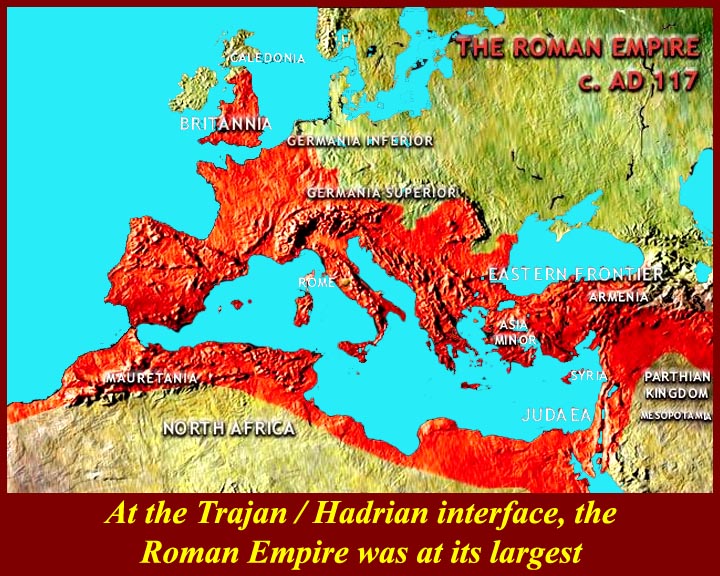
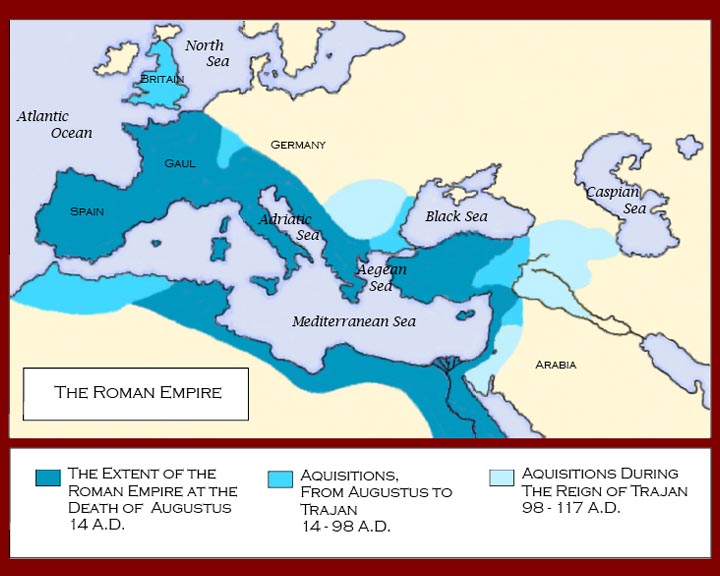
http://www.mmdtkw.org/AU0731aLargestEmpire.jpg
http://www.mmdtkw.org/AU0731bEmpireMap.jpg
http://www.mmdtkw.org/AU0731cProvincesMap.jpg
It was during this period -- more during the reigns of Trajan and his successor Hadrian -- that the Roman Empire was at its largest. Antoninus Pius temporarily pushed the northern border into Scotland and built the Antonine Wall north of Hadrian's Wall, but then quickly abandoned.
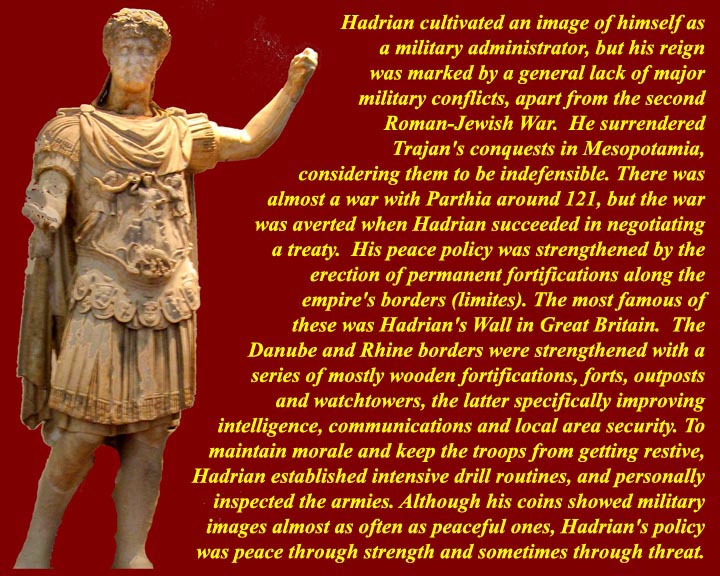
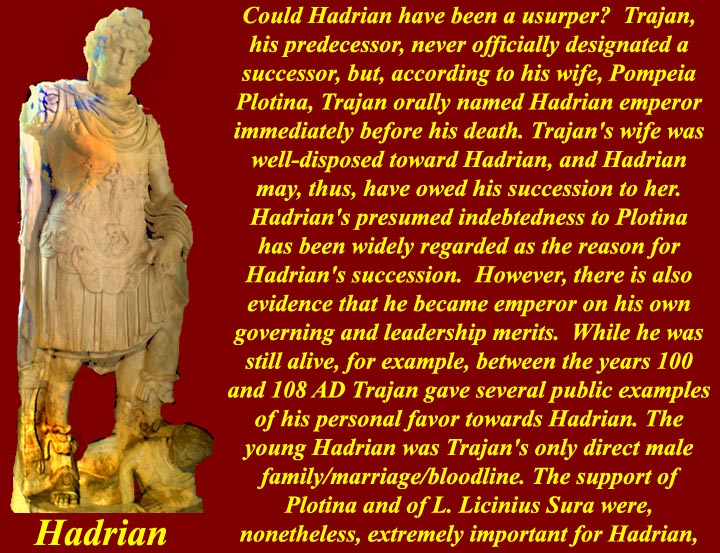
http://www.mmdtkw.org/AU0732aHadrian1.jpg
http://www.mmdtkw.org/AU0732bHadrian2.JPG
http://www.mmdtkw.org/AU0733Antinous.jpg
Just as Nerva had adopted Trajan, Trajan adopted Hadrian, another proven soldier and administrator. A member of the gens Aelia, Hadrian was the third of the Five Good Emperors, or the second of the recently proposed ulpio-aelian dynasty. His reign had a faltering beginning, a glorious middle, and a tragic conclusion. Trajan never officially designated a successor, but, according to his wife, Pompeia Plotina, Trajan named Hadrian emperor immediately before his death. Trajan's wife was well-disposed toward Hadrian; as such, Hadrian may well have owed his succession to her.
Hadrian's presumed indebtedness to Plotina was widely regarded as the reason for Hadrian's succession. However, there is evidence that he accomplished his succession on his own governing and leadership merits while Trajan was still alive. F or example, between the years 100-108 AD Trajan gave several public examples of his personal favour towards Hadrian, such as betrothing him to his grandniece, Vibia Sabina, designating him quaestor Imperatoris, Comes Augusti, giving him Nerva's diamond "as hope of succession", proposing him for consul suffectus, and other gifts and distinctions. The young Hadrian was Trajan's only direct male family/marriage/bloodline. The support of Plotina and of L. Licinius Sura (died in 108 AD) were nonetheless extremely important for Hadrian, already in this early epoch
Despite his own great stature as a military administrator, Hadrian's reign was marked by a general lack of major military conflicts, apart from the another Roman-Jewish War. He surrendered Trajan's conquests in Mesopotamia, considering them to be indefensible. There was almost a war with Parthia around 121, but the threat was averted when Hadrian succeeded in negotiating a peace.
The peace policy was strengthened by the erection of permanent fortifications along the empire's borders (limites, sl. limes). The most famous of these is the massive Hadrian's Wall in Great Britain, and the Danube and Rhine borders were strengthened with a series of mostly wooden fortifications, forts, outposts and watchtowers, the latter specifically improving intelligence, communications and local area security. To maintain morale and keep the troops from getting restive, Hadrian established intensive drill routines, and personally inspected the armies. Although his coins showed military images almost as often as peaceful ones, Hadrian's policy was peace through strength and sometimes through direct threat.
Hadrian was very active in promoting cultural affairs and the arts and was a prolific builder, both in Rome and in the provinces which he visited often. He traveled extensively and, in fact was said to have spent much more time on Imperial progresses and travels than in Rome. He visited Athens often to partake in the culture of Greece, which he much appreciated. Along the line he picked up a youg male Greek lover, whose eventual death by falling off a boat in the Nile devastated Hadrian.
Hadrian studied the architectural styles and inovations of the provinces and imported them to Rome and more particularly to his huge "villa" in Tiburtina (now Tivoli) where his aglomeration of copied structures is still a major tourist atraction and a summer theater venue. He is credited with designing the Pantheon in Roma and with the double temple of Venus and Roma -- the largest Roman temple ever built -- on a tract that had previously been part of Nero's Domus Aurea. (It's said that he was insulted by Trajan's great architect, Apollodorus, over the shape of the building and the size of the two cult statues and that Hadrian had exiled Apollodorus and then had him killed. ) For more information on his travels and his attempts to secure the imperial succession, see his biographies at http://en.wikipedia.org/wiki/Hadrian and at http://www.roman-emperors.org/hadrian.htm.
Hadrian never spent a great deal of time at his villa in Tiburtina and died after a protracted illness (now said to have been heart disease) in another imperial villa in Baiae on the Bay of Naples. The senate now felt it could repay the emperor for the wrongs done Trajan had done to it from the beginning of his reign and undertook to condemn his memory (damnatio memoriae). But Antoninus fought against this condemnation of his adoptive father and gained deification instead. It is generally thought that it was for this action that Antoninus received the name of Pius.
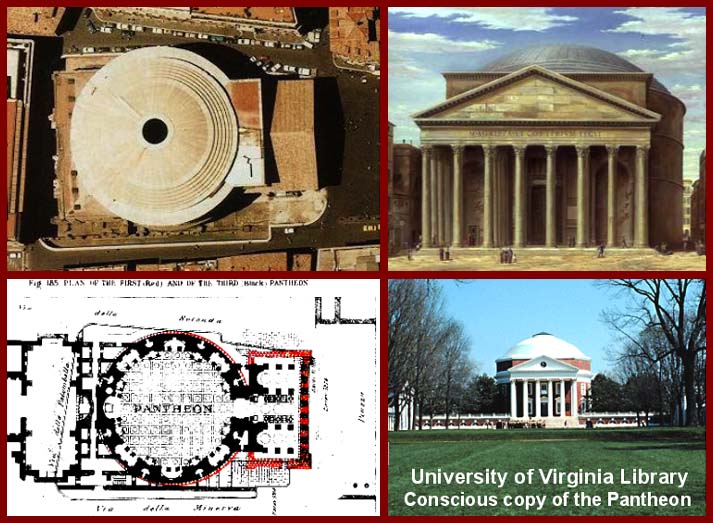
http://www.mmdtkw.org/AU0734aPantheon.jpg
http://www.mmdtkw.org/AU0734bPantheon2.jpg
Hadrian's pantheon was built on the site of the Pantheon that Agrippa had built to honor all the gods (pan+theos) that were sacred to the Julian gens of Octavian, his adoptive father and his father-in-law. Agrippa's Pantheon was much smaller occupying just the front porch of Hadrian's structure. There had actually been at least one intervening Pantheon on the site; both of the two earlier structures were destroyed in fires. Agrippa' pantheon had faced a large circular plaza. Hadrian reversed the temple's orientation and built the huge concrete dome of his structure where the circular plaza had been. The Pantheon dome is the largest unreinforced concrete dome in the world. For more information on the Pantheon, see http://www.mmdtkw.org/RT04-Pantheon.html.
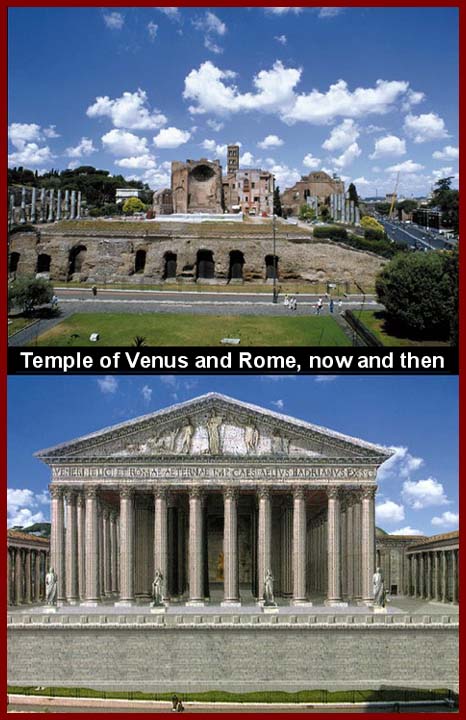
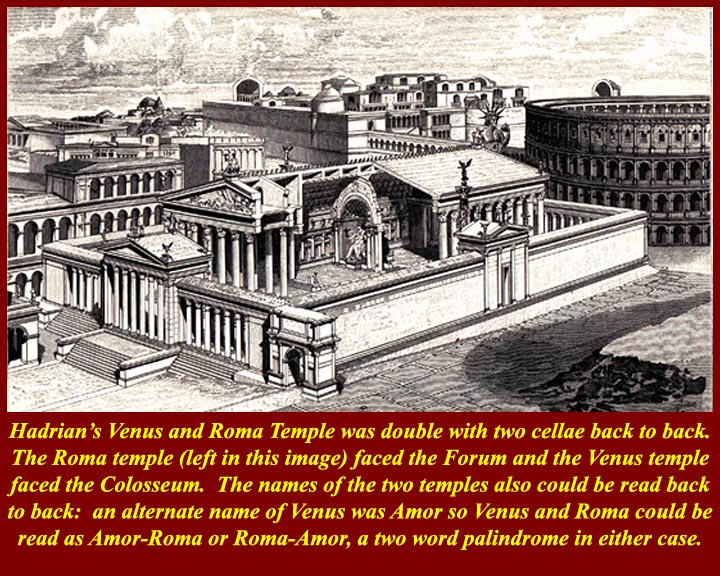
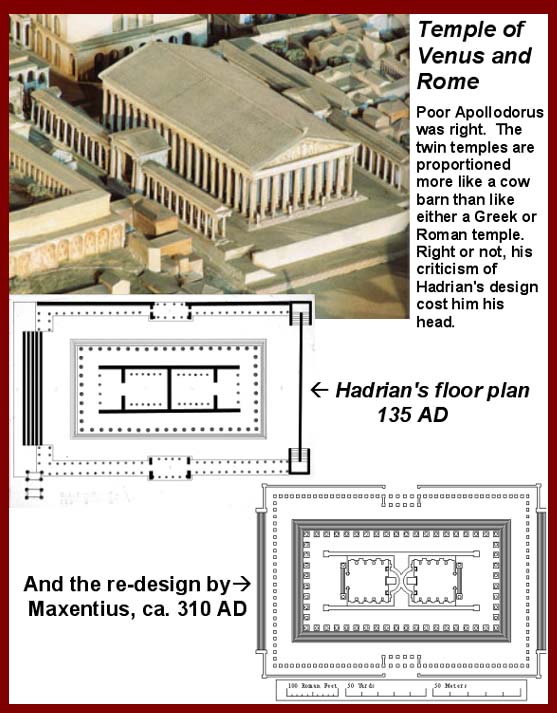
http://www.mmdtkw.org/AU0735aVenusRomeThenNow.jpg
http://www.mmdtkw.org/AU0735bVenusRoma.jpg
http://www.mmdtkw.org/AU0735cVenusRomeModelPlans.jpg
http://www.mmdtkw.org/AU0735dVenusRoma2.jpg
For an article on the Temple of Venus and Rome, see http://www.mmdtkw.org/VTempleVenusRome.html.
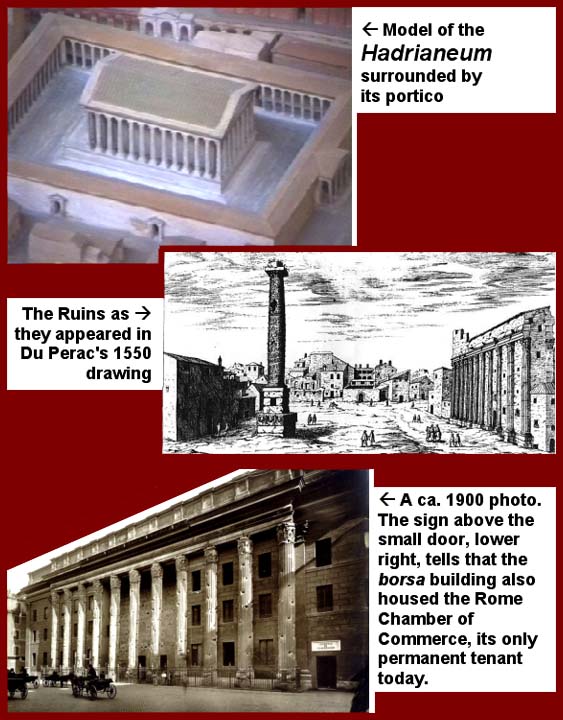
http://www.mmdtkw.org/AU0736aHadrianeum2.jpg
http://www.mmdtkw.org/AU0736bHadrianeum1.jpg
Only part of the Hadrianeum, the Temple of deified Hadrian in Rome, is standing, and that part is built into a renaissance structure, which housed the Roman Renaissance and later "bursa" or stock exchange and the chamber of commerce. A large part of the interior of the renaissance structure is now used as a gallery for traveling art exhibits and for industrial exhibitions. for an article on the structure see http://www.mmdtkw.org/VHadrian.html.
http://www.mmdtkw.org/AU0737HadrianMausoleum.jpg
Hadrian's tomb was incorporated into Rome's defenses and eventually converted into a papal fortress, Castel Sant'Angelo. For an article on the tomb and on the fortress, see http://www.mmdtkw.org/RT04-HadrianTomb.html.
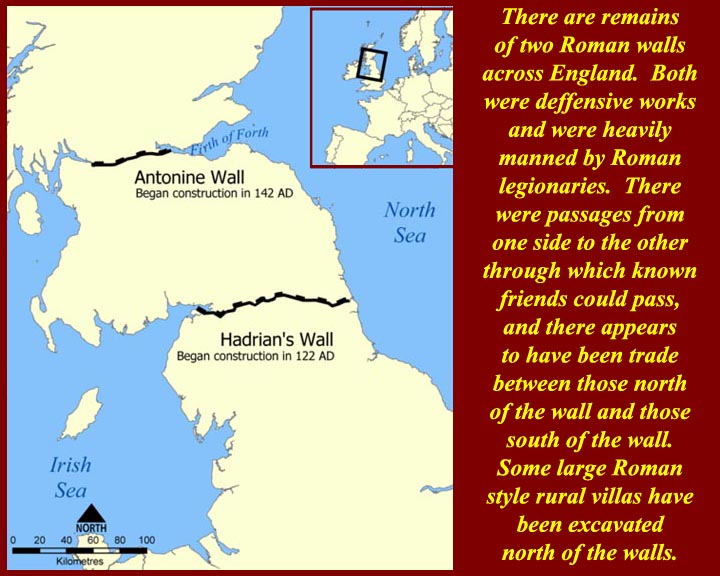
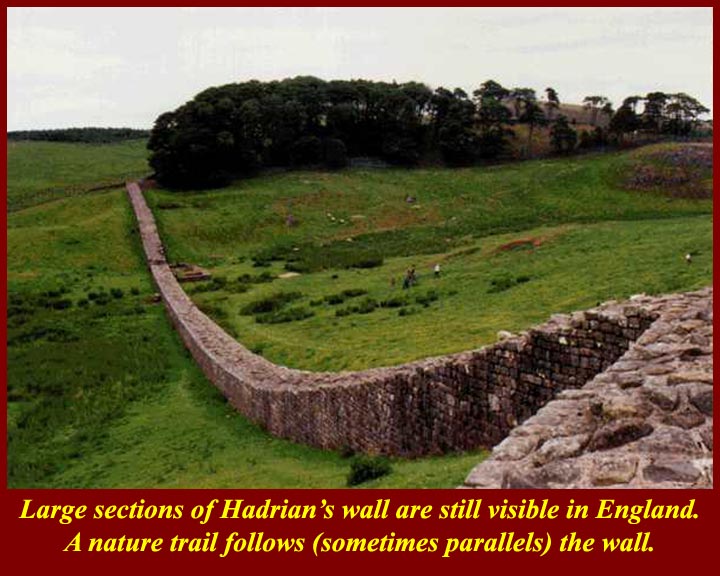
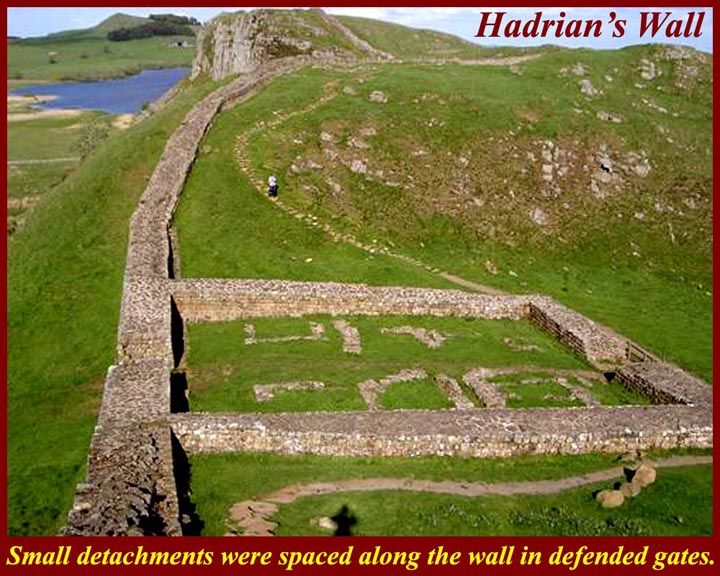
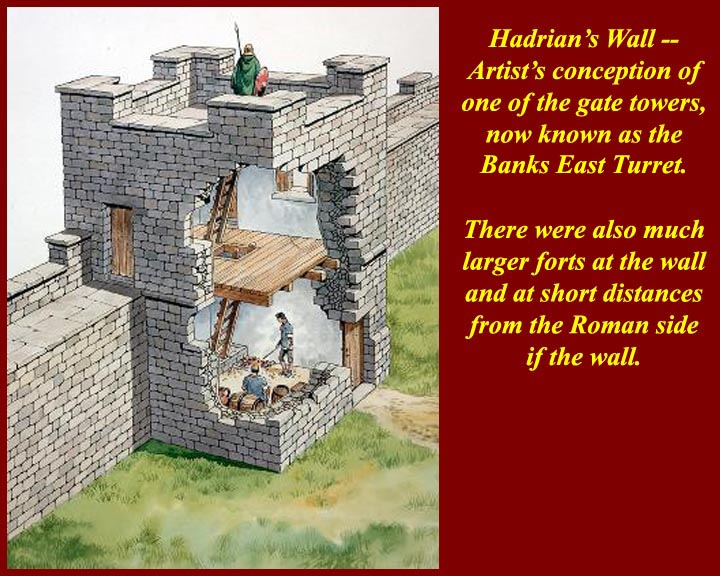
http://www.mmdtkw.org/AU0738aHadriansWallMap.jpg
http://www.mmdtkw.org/AU0738bHadrianWall2.jpg
http://www.mmdtkw.org/AU0738cHadrianWall3.jpg
http://www.mmdtkw.org/AU0738dBanksEastTurret.jpg
http://www.mmdtkw.org/AU0738eHousteadRomanFort.jpg
Among Hadrian's great achievements was the stabilization of the Roman Empire's borders (Latin < limes >). In most areas, this was accomplished by building wooden walls and structures, but his wall forts and camps across England were built mostly of stone -- at least the foundations were. The wall and foundations are now the centerpiece of a hiking trail right across England. (See http://www.nationaltrail.co.uk/hadrianswall/.)
It was long thought that Hadrian's wall and forts were designed to keep out whoever might be to the north of the fortifications, but more recent study indicates that they were built to show Roman power and thereby prevent anyone from contemplating an attack. The guard towers always had doors opening to both sides of the wall, and it's thought that passage through the wall (with appropriate security checks and customs controls) was fairly easy to negotiate. Roman style villas have been found and excavated north of the wall and all the way up into Scotland Indicating that either Roman traders lived well north of the wall or that local leadership/elites were "Romanized". There are almost 1.5 million Hadrian's Wall sites on the Internet. Just click here or type Hadrian Wall in the search window of your web browser.
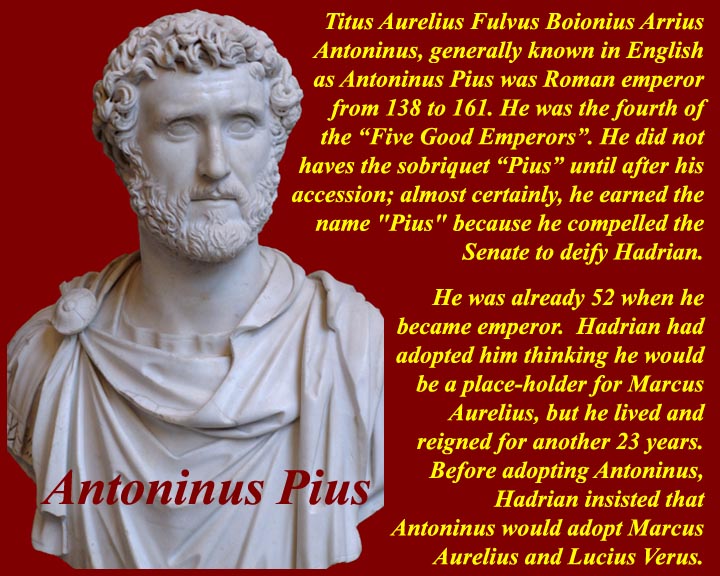
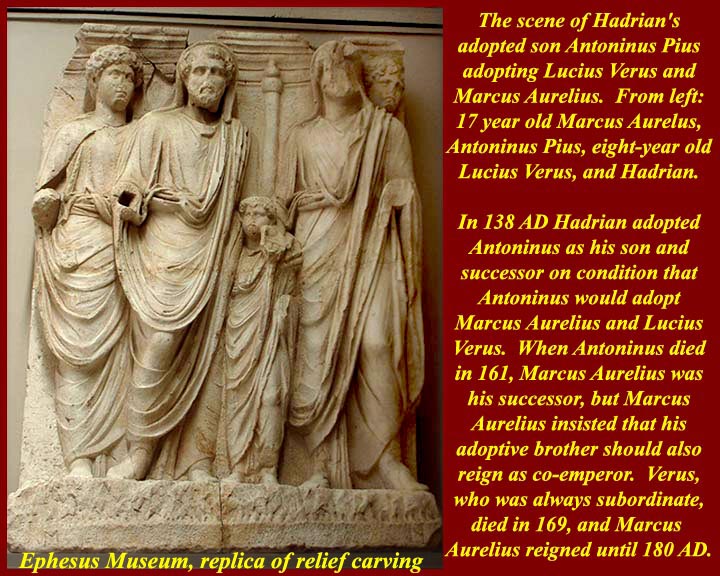
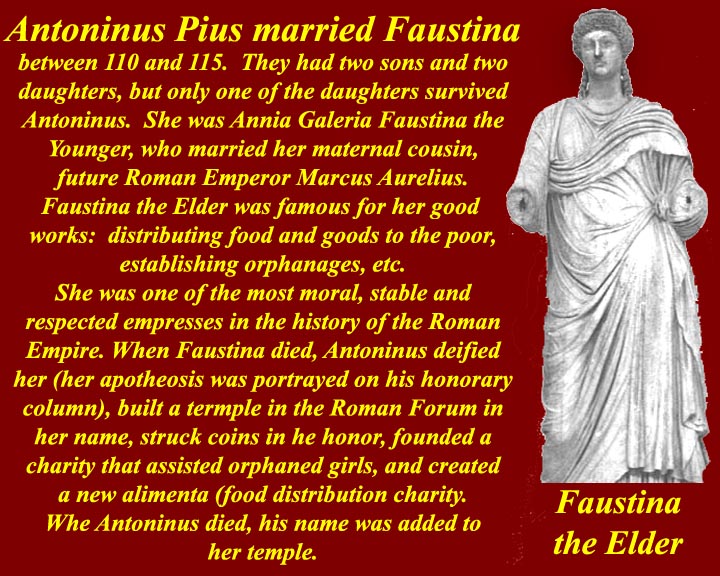
http://www.mmdtkw.org/AU0739aAntoninusPius.jpg
http://www.mmdtkw.org/AU0739bAdoptionRelief.jpg
http://www.mmdtkw.org/AU0739cFaustina.jpg
http://www.mmdtkw.org/AU0739dDivusAntonin.jpg
Hadrian thought that Antoninus Pius (named Pius because he convinced the reluctant Roman Senate to deify Hadrian) would be a place-holder for one of his adoptive grandsons. Hadrian adopted Antoninus, but only after Antoninus adopted Marcus Aurelius and Lucius Verus. Some historians think that Hadrian wanted Verus to be Emperor, but that Antoninus later gave precedence to Marcus Aurelius, who was several years older. In any case, both had a long wait. Even though Antoninus was already at least 50 years old when he became Emperor, he reigned for 23 years. Unlike Hadrian, Antoninus was a homebody, and no record exists of him ever leaving the Italian peninsula. He was strictly a civil administrator and it's doubtful that he ever got anywhere near a Roman legion. He was a devoted husband to Faustina the Elder, and she turned out to be a perfect wife and a "first lady" type consort, who did all the right charitable ans social good works. His life and works can be found at http://www.roman-emperors.org/tonypis.htm and a bio note on Faustina is at http://en.wikipedia.org/wiki/Faustina_the_Elder. Antoninus and Faustina had four children together, but the two sons and on of the daughters predeceased Antoninus. The Other daughter, Faustina the Younger, married Marcus Aurelius who would become the next Emperor.
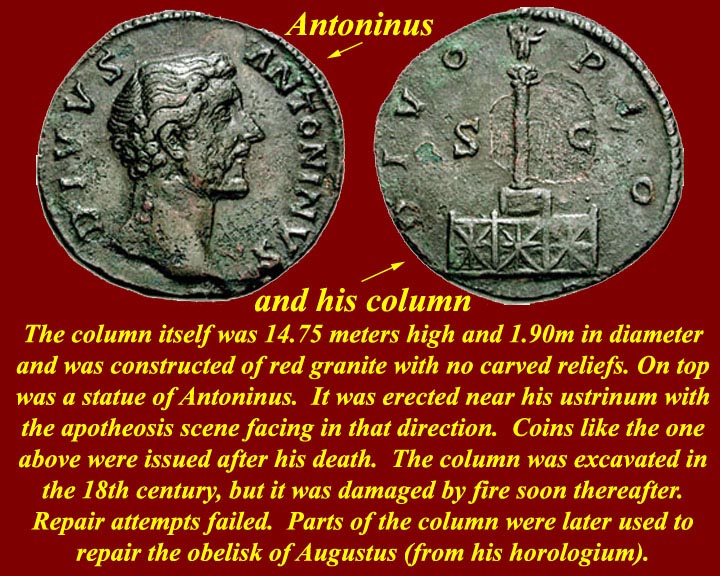
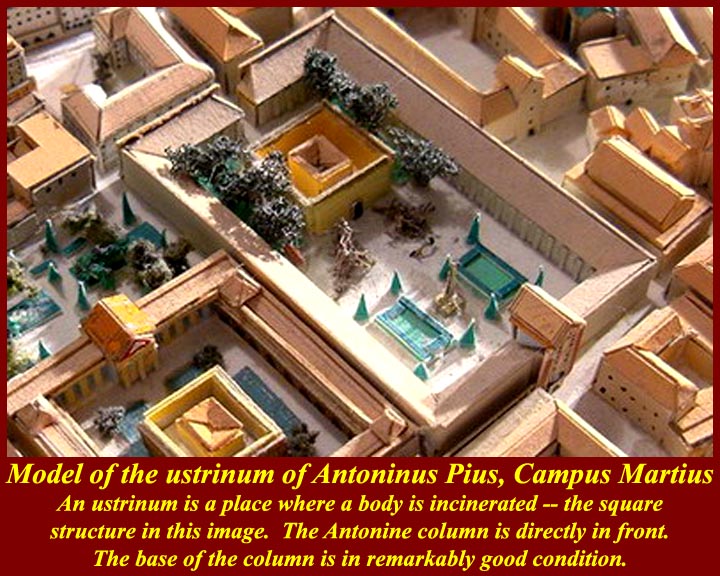
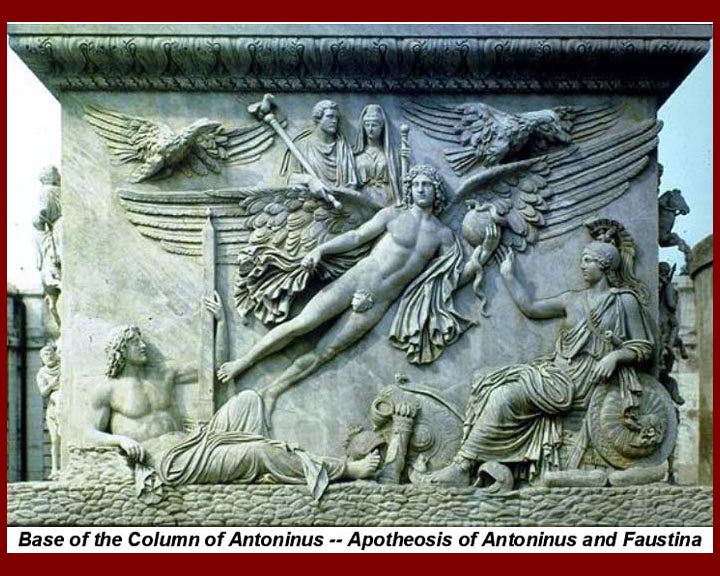
http://www.mmdtkw.org/AU0740aaAntoninColumnCoin.jpg
http://www.mmdtkw.org/AU0740bAntoninusUstrinumColumn.jpg
http://www.mmdtkw.org/AU0740cBaseColAntoninus1.jpg
http://www.mmdtkw.org/AU0740dBaseColAntoninus2.jpg
The column of Antoninus was a single piece of undecorated red granite 14.75 meters high and 1.90 meters in diameter. The column was raised from the ground by Carlo Fontana's son Francesco (1668-1708), but no decision was made about its use. It, thus, remained lying on the ground under some sheds, and was finally damaged by fire in 1759. Unsuccessful attempts were made to repair it soon afterwards in 1764, with some pieces from it being used in 1789 to restore the obelisk of Augustus that was the gnomen of his great horologium (sun dial) and is now in the Piazza di Monte Citorio in front of Palazzo Montecitorio which houses the Italian Chamber of Deputies.
The base, of white Italian marble, was restored in 1706-08 and was erected in the center of Piazza di Montecitorio by Ferdinando Fuga in 1741. It was taken to the Vatican Museums in 1787. Its current position is in the courtyard outside the entrance to the Vatican Pinacoteca. A description of the apotheosis and decursius reliefs on the sides of the base along with images of details is at http://www.bluffton.edu/~sullivanm/romanpius/romanpius.html. The column and its base were part of the ustrinum of Antoninus. An ustrinum was the place where a body was incinerated. "Incineratus" in Latin meant "reduced to ashes".
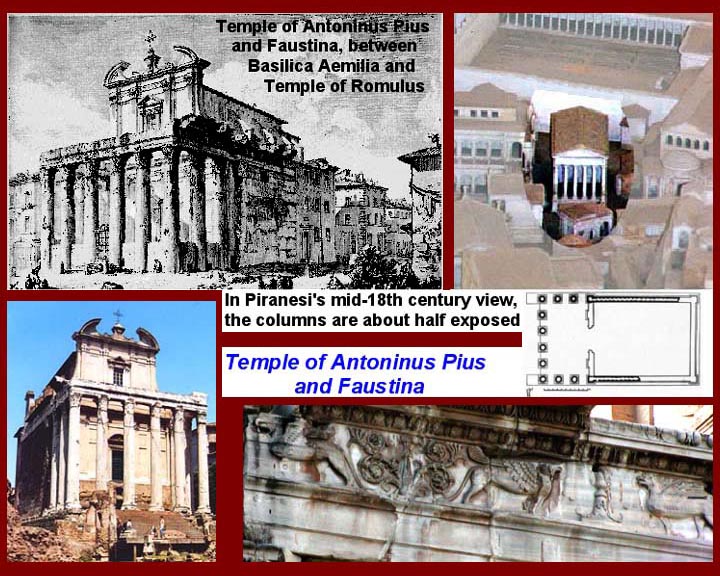
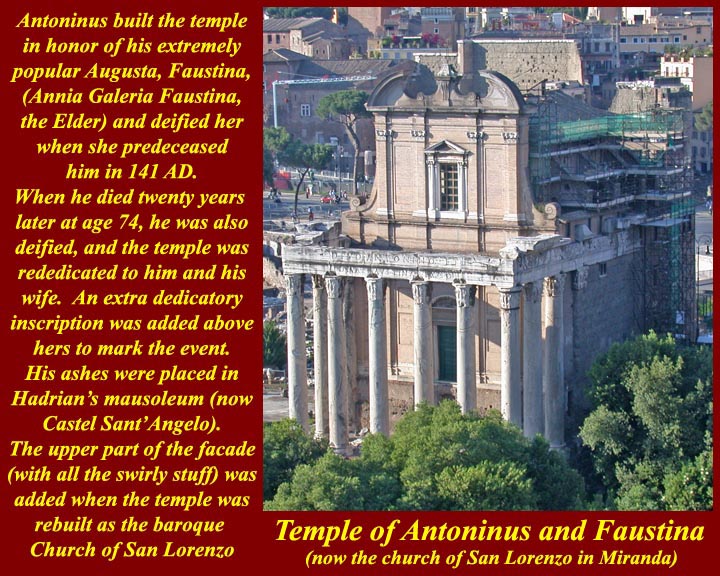
http://www.mmdtkw.org/AU0741aTempleAntoninusFaust.jpg
http://www.mmdtkw.org/AU0741bAntoninusFaustinaTemple.jpg
http://www.mmdtkw.org/AU0741cAntoninFaustinTemple.jpg
When Faustina died in 141 AD at about the age of 41 Antoninus had her deified and built this large temple in her honor at the edge of the Republican Forum. After he died in 161, the temple was rededicated to both Antoninus and Faustina in the 7th or 8th century, the temple was converted into the church of San Lorenzo in Miranda. The Platner and Ashby Topographical Dictionary of Ancient Rome entry for the Temple is at http://penelope.uchicago.edu/Thayer/E/Gazetteer/Places/Europe/Italy/Lazio/Roma/Rome/_Texts/PLATOP*/Templum_Antonini-Faustinae.html
and pictures of some details of the pronoas (front porch) are available at the bottom of http://sights.seindal.dk/sight/175_Temple_of_Antoninus_and_Faustina.html.
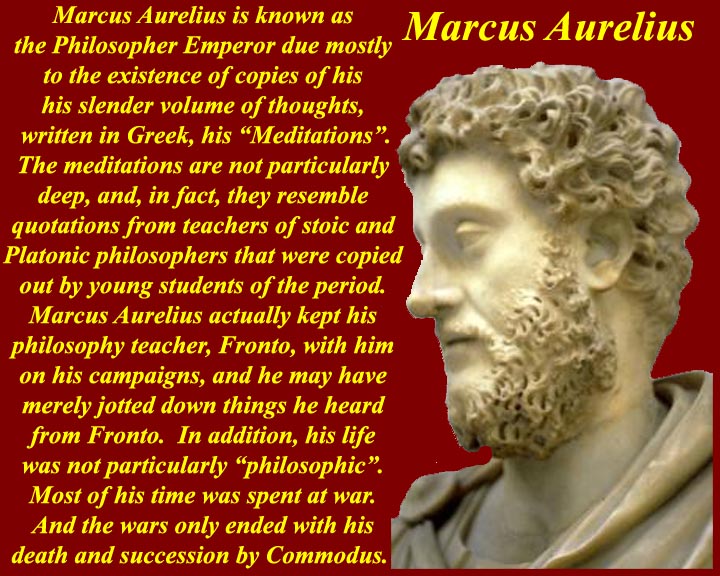
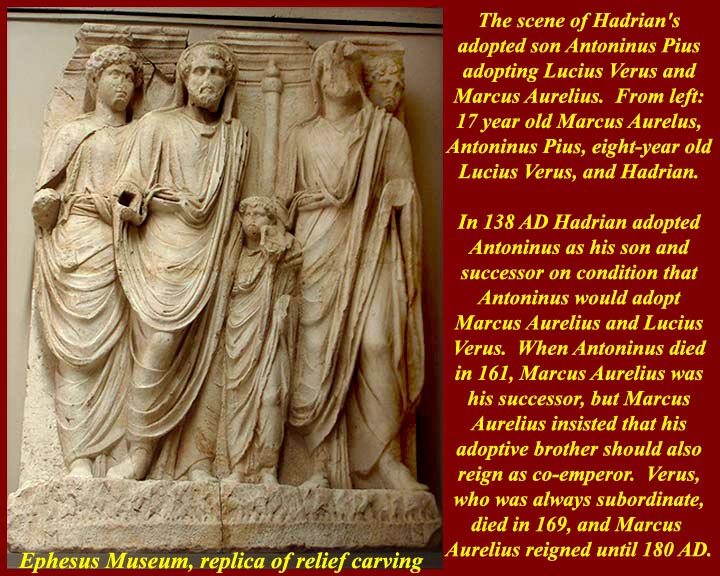
http://www.mmdtkw.org/AU0742aMarcus_aurelius.jpg
http://www.mmdtkw.org/AU0742bAdoptionRelief.jpg
http://www.mmdtkw.org/AU0742cMAureliusShares.jpg
Marcus Aurelius has long been known as the Philosopher Emperor mostly because a book later entitled as his "Meditations" has come down to us. The book has also been called, in some translations, the "Golden Book" of Marcus Aurelius. In fact, it reads like a student's copy book from a very basic course in Stoic and/or Platonic philosophy rather than the work of a mature philosopher. (It even has been described as a "Little Golden Book" comparing it with the children's early reading book series.) Marcus Aurelius did take his philosophy teachers on campaigns with him, however, so if not a real philosopher, he can at least be classified as a persistent student of philosophy. Another supposed sign that Marcus Aurelius was a "philosopher" was his "philosopher's beard". We have seen, however that the beard came into style with his predecessors.
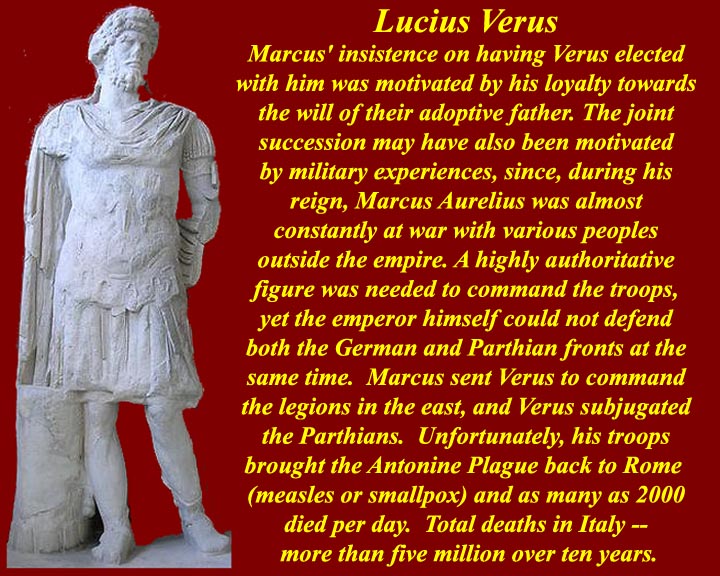
http://www.mmdtkw.org/AU0743aLuciusVerus.JPG
http://www.mmdtkw.org/AU0743bLuciusVerusVictoria.jpg
When he succeeded Hadrian, one Marcus Aurelius's first acts was to have his adoptive brother, Verus, made emperor with him. Although Verus was always the junior partner, it worked out well, because Verus, a less ambitious type, never challenged Marcus and because there were plenty of challenges from outside the borders to keep more than one emperor busy. Verus, as it turned out, would be a successful general in the eastern wars -- if we count success as winning the war by delegating the real inland fighting to subordinates (supplied by Marcus) while he, Verus, partied at the coastal headquarters. At any rate, he and Marcus shared a triumph.
When he returned to Rome, Verus continued his debauchery. After returning from the East, Lucius showed far less deference to his brother and far less interest in his own official responsibilities than he had prior to the Parthian War. As Lucius continued to neglect the obligations of state another conflict erupted, this time on the empire's northern perimeter. As hostilities increased along the frontiers they only added to Marcus' burdens. At this point the leading enemies of Rome were the Marcomanni, a Germanic tribe. But because other Germanic tribes were also involved, the war became known as bellum Germanicum. The tribal incursions lasted from 167-180, and were fought in three distinct phases. Lucius participated in the first campaign although he was not given the leadership assignment he had abused during the Parthian War. Marcus persuaded the Senate that both he and Lucius were needed at the battle front. The older emperor had undoubtedly learned that he should neither send Lucius to war alone nor leave him at home to indulge himself further in the debauchery that had become his unsupervised lifestyle. Thus both emperors set out for the northern front in the spring of 168. While the two emperors and their entourage were returning to Rome in 169, Lucius Verus suddenly became ill and died within three days. There were, of course, rumors of poisoning either by Marcus Aurelius or by his wife, Faustina the Younger (who was also the mother-in-law of Lucius Verus and who in some rumors was also accused of having an incestuous relationship with Lucius Verus). There was never any evidence that these rumors had any basis in fact.
On arrival in Rome, Marcus Aurelius arranged the funeral of his brother, provided for the care and income of his brother's family and dependents (slaves, freedmen, and clients) and had him deified as Divi Verus.
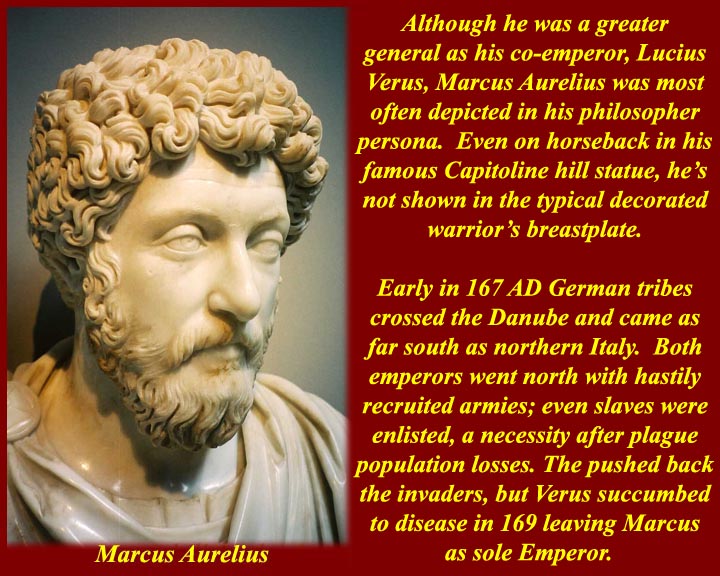
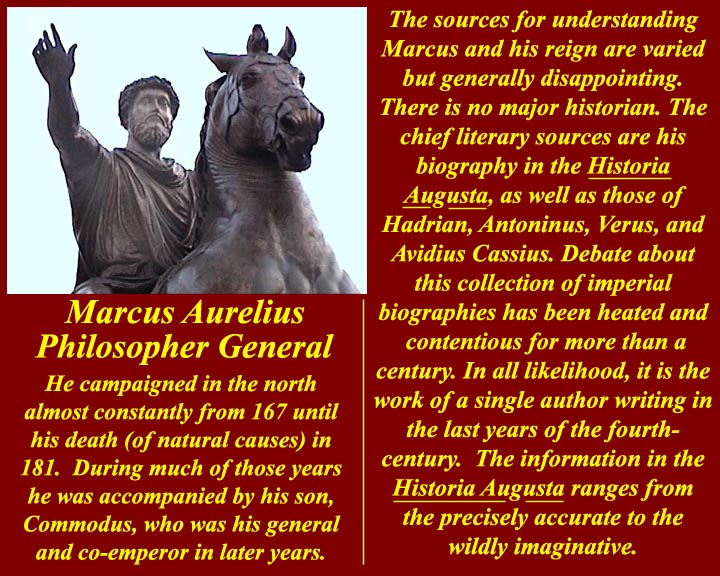
http://www.mmdtkw.org/AU0744aPhilosMarcusAurelius.jpg
http://www.mmdtkw.org/AU0744bSourcesMarcusAurelius.JPG
http://www.mmdtkw.org/AU0744cMAureliusStatue.jpg
Although many of not most of the known images of Marcus Aurelius show him in civilian rather than military garb, he actually spent most of his time as emperor on Danubian battlefields. His son, Commodus was with him from an early age, and by the time he was a teen-ager, Commodus had learned the business of war. He reportedly trained with the troops and dedicated himself to excelling in the use of all military and gladiatorial weapons. By the end of the life of Marcus Aurelius, Commodus, still in his teens, was de facto commander of the armies on the Danube while Marcus Aurelius was the overall commander. The bio of Marcus Aurelius is at http://www.roman-emperors.org/marcaur.htm.
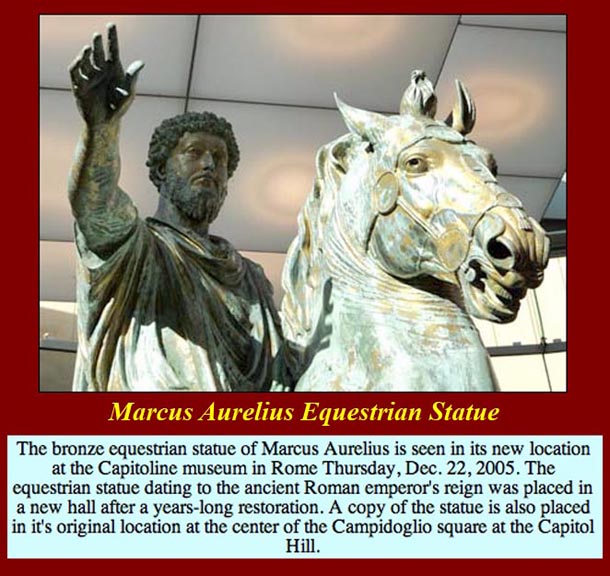
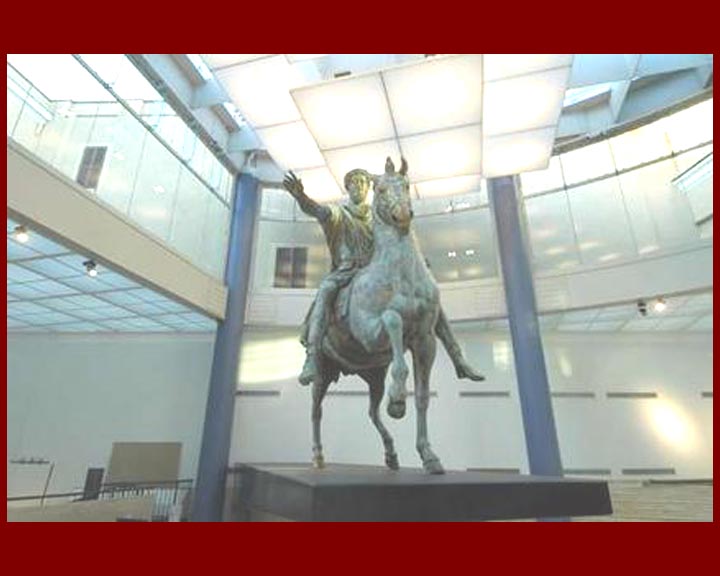
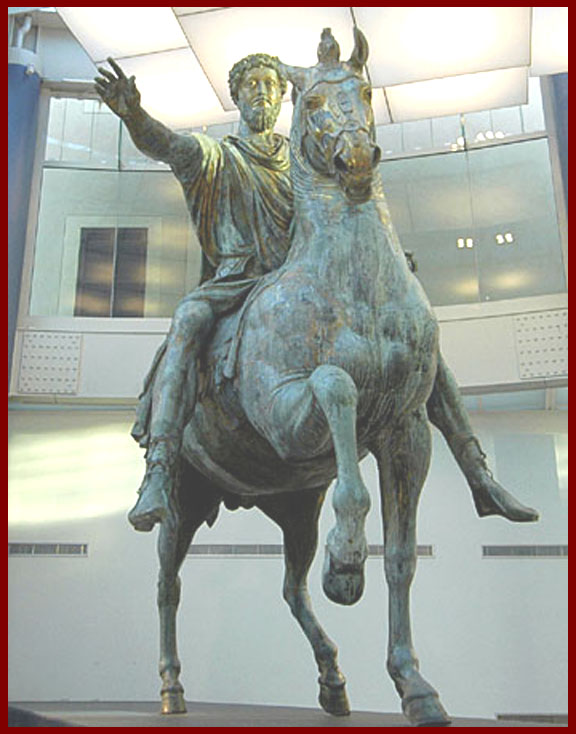
http://www.mmdtkw.org/AU0745aMarcusAureliusEquest.jpg
http://www.mmdtkw.org/AU0745bMarcusAureliusEquest3.jpg
http://www.mmdtkw.org/AU0745cMarcusAureliusEquest2.jpg
http://www.mmdtkw.org/AU0745dMAureliusCampidoglio.jpg
One of the few Roman bronze statues to escape the foundries of medieval and renaissance cannon makes is this heroic equestrian statue of Marcus Aurelius. And the only reason it probably escaped is that it was long thought to be a statue of the hero of Roman Christianity
Constantine. Very early representations of the statue sometimes showed a crushed barbarian below the horse's raised hoof, but he had disappeared by the time Michelangelo moved the statue in 1538 from near the front of the papal Lateran Palace to the Capitoline Hill. The statue now in the center of Michelangelo's Capitoline square is a replica erected in 1981 when the original was taken inside the Palazzo Nuovo Capitoline Museum for conservation and repair. The original is now displayed in a new hall of the The original is on display in the Palazzo dei Conservatori of the Capitoline Museum.
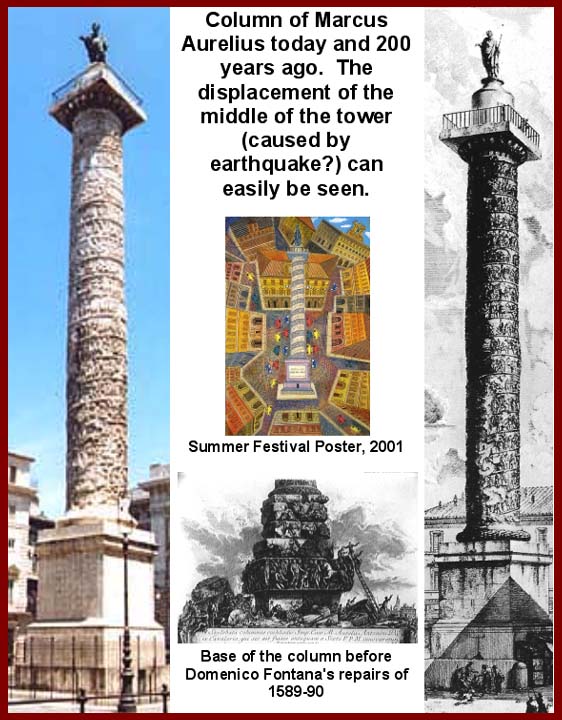
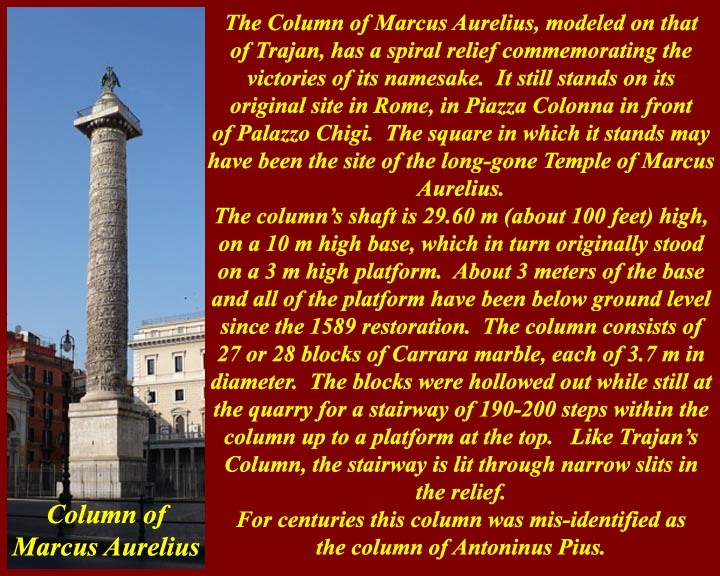
http://www.mmdtkw.org/AU0746aColumnMAurelius.jpg
http://www.mmdtkw.org/AU0746bMAureliusColumn.jpg
http://www.mmdtkw.org/AU0746cMAureliusColumn-2.jpg
Because the original dedicatory inscription has been destroyed, it is not known whether it was built during the emperor’s lifetime (on the occasion of the triumph over the Teutons and Sarmatians in the year 176) or after his death in 180; however, an inscription found in the vicinity claims that the column was completed in 193.
The spiral picture relief tells the story of Marcus Aurelius’ Danubian or Marcomannic wars, waged by him from 166 to his death. The story begins with the army crossing the river Danube, probably at Carnuntum. Because of the height restriction, a Victory separates the accounts of the two expeditions. The exact chronology of the events is disputed, however the latest theory states that the expeditions against the Marcomanni and Quadi in the years 172 and 173 are in the lower half and the successes of the emperor over the Sarmatians in the years 174 and 175 in the upper half.
In spite of many similarities to Trajan’s column, the style is entirely different, a forerunner of the dramatic style of the 3rd century and closely related to the triumphal arch of Septimius Severus, erected soon after. The figures’ heads are disproportionately large so that the viewer can better interpret their facial expressions. The images are carved less finely than at Trajan’s Column, through drilling holes more deeply into the stone, so that they stand out better in a contrast of light and dark. As villages are burned down, women and children are captured and displaced, men are killed, the emotion, despair, and suffering of the "barbarians" in the war, are represented acutely in single scenes and in the figures’ facial expressions and gestures, whilst the emperor is represented as a protagonist, in control of his environment.
The symbolic language is altogether clearer and more expressive, if clumsier at first sight, and leaves a wholly different impression on the viewer to the whole artistic style of 100 to 150 as on Trajan’s column. There, cool and sober balance – here, drama and empathy. The pictorial language is unambiguous - imperial dominance and authority is emphasized, and its leadership is justified.
About 3 meters of the column's base have been below ground level since 1589 when, by order of pope Sixtus V, the whole column was restored by Domenico Fontana and adapted to the ground level of that time. Also a bronze statue of the apostle St. Paul was placed on the top platform, to go with that of St. Peter on Trajan’s Column. (Originally the top platform probably had a statue of Marcus Aurelius, but it had been already lost by the 16th century.) That adaptation also removed the damaged or destroyed original reliefs on the base, garland-carrying victories carrying and (on the side facing the via Flaminia ) representations of subjected barbarians, and replaced them with an inscription mistakenly calling this column the column of Antoninus Pius.
More information on the Column of Marcus Aurelius is at http://www.mmdtkw.org/VMarAurColumn.html and
http://www.livius.org/a/italy/rome/col_marcus/col_marcus.html.
(a)(b)
(c)
http://www.mmdtkw.org/AU0747aMarcusAureliusArch.jpg
http://www.mmdtkw.org/AU0747bConstantineArch.jpg
http://www.mmdtkw.org/AU0747cConstantineArchSpolia.jpg
The three panels in image (a) are thought to have been originally on a triumphal arch of Marcus Aurelius, which may have stood near the junction of the Via Argentarius and Via Lata, near the Roman Forums. Some relief panels from the supposed arch of Marcus Aurelius are among the spolia used to decorate the Arch of Constantine near the Colosseum.
An illustration similar to that shown in image (c) is at http://www.rome101.com/ArchConstantine/#116, and by scrolling down images of the Marcus Aurelius panels in the arch of Constantine can be found. (A few of the larger images available by clicking on the images, to which we can scroll, a inexplicably missing.)
The assumed original subject of these attic panels on the arch of Constantine is Marcus Aurelius, but, they are now all Constantine. The current Constantine heads were replaced in 1732, presumably as restorations of earlier-recarved heads of Constantine. Three other panels, thought by most to be of the same series (thus a now-lost arch of Marcus Aurelius would have had twelve or more panels) are displayed in the Capitoline Museum. Some experts, however think that those in the Capitoline Museum are from a different earlier arch also dedicated to Marcus Aurelius.
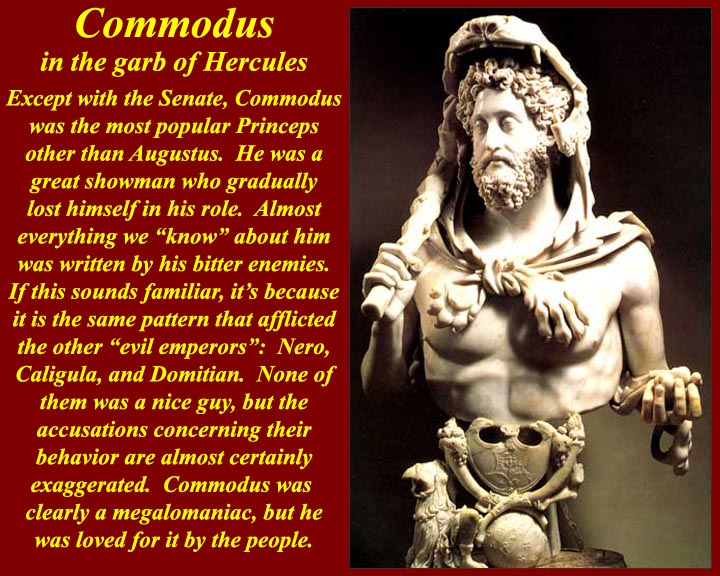
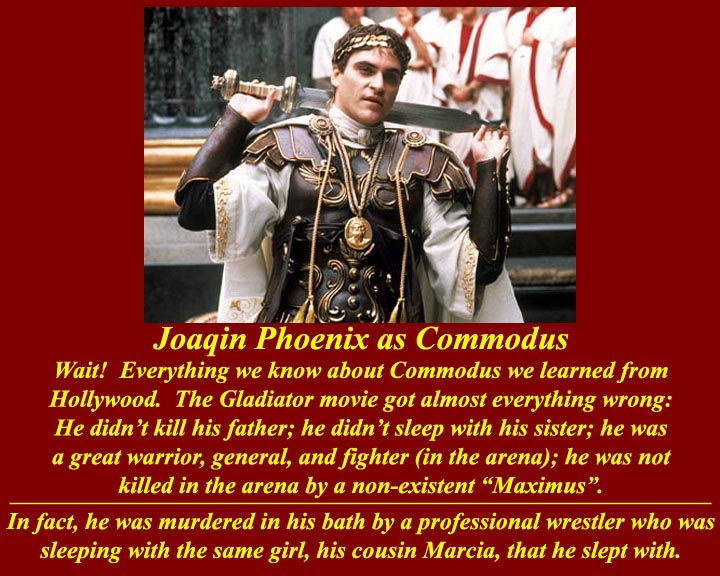
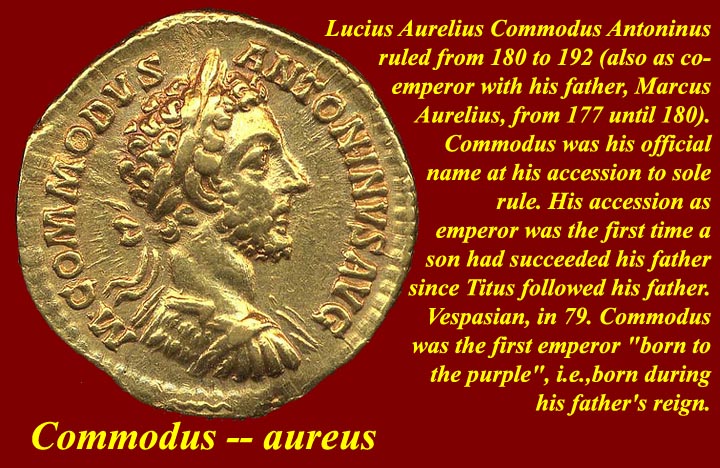
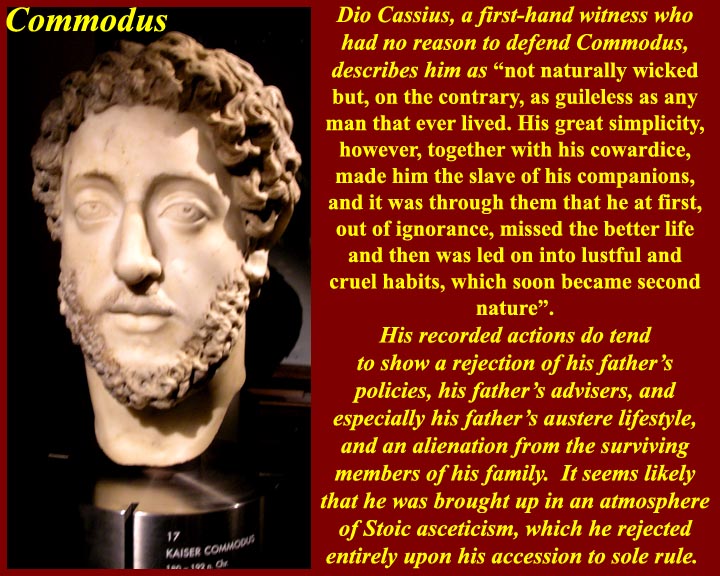
http://www.mmdtkw.org/AU0748aCommodusHercules.jpg
http://www.mmdtkw.org/AU0748bCommodusJoaquinPhoenix.jpg
http://www.mmdtkw.org/AU0749aCommodusBornPurple.jpg
http://www.mmdtkw.org/AU0749bCommodusRejectsStoicism.jpg
http://www.mmdtkw.org/AU0749cParanoidCommodus.jpg
Marcus Aurelius had a son, unlike the other four of the Five Good Emperors. Commodus has been reviled from the day that he was killed in a Senate coup. The initial argument between the Senate and Commodus may have been about his ending of the war of his father, Marcus Aurelius, along the Danube.
Commodus had been on the battle front with his father for several years before Marcus Aurelius succumbed to some undefined "plague". By the time of his father's death, Commodus had worked his way up through the ranks if his father's army and had become his father's top field commander. He was said to have really served at all ranks and learned the warcraft of everyone from the common trooper through the higher officer ranks. He was skilled in the use of all the army's weaponry and had also practiced with gladiators to learn their skills.
When Marcus Aurelius died, Commodus finished the Danubian wars, straightened the boundary lines, withdrew from a few bridgeheads north of the Danube, and made treaties with his former enemies. Then he marched back to Rome. And that was the problem. The Senate had been very satisfied to have the emperor in the "far north" while they dealt with his representatives. They also may well have liked their place in the "military industrial complex" that Commodus proceeded to dismantle. They didn't like the prospect of returning troops who would have to be given land, some of which would have been in Italia -- land that the Senators wanted to keep for themselves. They certainly would not have wanted a fun-loving charismatic leader in Rome, and Commodus, as it turned out was just that. After years of living under the thumb of his stoic father, Commodus completely rejected stoicism and started to party. The common people loved him; he was one of the most popular emperors ever and approached the popularity of Augustus. (Popular here with both meanings: loved by the people and "populist" like the old leaders of the Roman "populares".
The Senate and other members of the upper class started to plot against him early in his 15 year reign, and they kept at it until they succeeded in assassinating him. The constant plotting made him suspicious of everyone -- even his own sister had participated in one of the plots that he foiled. By the end, he was probably paranoid and could easily have also been diagnosed as a megalomaniac. The final plot succeeded -- that's why it was the final plot, of course. His mistress, a first cousin named Marcia, got her other boyfriend, a professional wrestler, to strangle Commodus in his bath.
We also here have, once again, the problem of hostile and unreliable historians as our only sources of information about Commodus. It's impossible to say whether he was as nutty or as evil as they claimed. Winners get to write the histories, and Commodus didn't win. On the other hand, apologists for Commodus, like those for Caligula, Nero, Domitian, and some others that came after Commodus, have to swim against the tide of "evidence" that these guys really were bad.
The Gladiator movie got almost everything wrong. Commodus did not kill his father. He did not sleep with his sister, who had been married to Verus (she was already dead after an earlier plot) or with any other sister. There was, in fact, no known gladiator like the one in the movie; Commodus did not die in the arena at the hand of a gladiator, but he did occasionally show off by fighting in the arena and winning ( -- we'll never know if his opponents threw their fights). He also was famous for his participation in the venationes in the arena but it's impossible to know if the animals he hunted or fought were drugged or overfed before he went in after them.
The bloody scenes which upset many viewers of the movie didn't come near doing justice to the blood and gore of the real arenas. Ancient Romans had no qualms about snacking in the grandstands while the blood flowed. Young boys were taken to the arenas to harden them for their inevitable stints in the Roman army, which were necessary for advancement in the militarist imperialist state.
The scenery and costumes in the movie were, however, pretty accurate, but not as accurate as the scenery, costumes, and ambiance of the Rome television series, which also had a Hollywood (Rome Cinecitta) story line rather than anything more than vaguely connected with historical fact.

